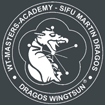|
|
CLASSICAL WING TSUN
Compact Course of Classical Wing Tsun in 10 Small Tutorials
Compact Course on Classical WT (free)
10 Simple Lessons of Self-Defense for Anyone

Using basic classical Wing Tsun, in this compact course, Melanie Heisch, Jan Knobloch and Carsten Schmitt demonstrate in 10 simple lessons, effective techniques for emergencies.
CLASSICAL WING TSUN EXTENDED - Part 1: Corteous Intervention
The Roots - Preface to CLASSICAL WING TSUN
The Roots - Preface to CLASSICAL WING TSUN
Foundation Of Classical Wing Tsun
Simple Techniques For Self Defense
This free Wing Tsun course is suitable for beginners. It contains 121 exercises of simple and fast to learn self defense techniques. The maneuvers shown are based on the classical Wing Tsun (Leung Ting system), which I learnt from 1983-1999. But also those developements I made by my own during that time - especially aspects which do not exist in the classical Wing Tsun system (e.g. ground fighting, knive defense) have been added, too.
It took me time and courage to overcome my own demands on perfection to publish this work. The reason for this is it has been originated in 1999 and thus does not represent what I am teaching today in any means! The DRAGOS WING TSUN I am teaching today is verdy different to the classical WT. Therefore to publish this work may always provide a surface for attack and criticism. I guess thats just life and I have to accept it. I spent half of my life in evolving and perfecting all aspects of the Wing Tsun martial art. If you want to see a glimpse of what I do today just switch over to "Excerpts from the DRAGOS WING TSUN Online-Academy (DWT 3.0)".
Nevertheless, every journey begins with a first step. For those who don`t have the time or energy to learn a martial art in the sence of perfection these easy to learn CLASSIC WING TSUN exercises might be helpful and sufficient.
Those who want to go beyond what is shown in this course are invited to learn the more sophisticated DRAGOS WING TSUN system. Fun, exitement and a never ending challenge of learning and growing is waiting for you!
I hope to see you on the other side..
Sifu Martin Dragos

Introduction - Phases of Emergency Conflict
CLASSICAL WING TSUN EXTENDED
Phases of Emergency Conflict
In the first part of this course you will learn:
• Psychological contexts and conflict prevention strategies
• Simple basic techniques
• Preventive action, i.e. approaches of interventions to prevent attacks
Self-Defense begins in the Mind
Self-defense does not begin when we realize that we are being exposed to an attack that threatens our body or life, but long before that. We are all familiar with everyday situations where someone takes our space or restricts us from something: the driver of the car in the parking lot, who takes our spot "under our nose" or the citizen who steals your place in the huge line of cinema - these are clear examples of seemingly "harmless" situations. However, such situations can lead to more severe conflicts. The most important thing is to recognize, on a psychological level, what is happening in each case. In this way, we can observe the following phases of the emergence of conflicts:
Phases of Emergency Conflict
Phase 1: Visual perception and assessment of the situation by the aggressor
In the initial phase, the definition of who will be our "aggressor" is still not very clear. Through evaluation, using his knowledge of human nature and by means of direct eye contact, the bully tries to produce an image of our strengths and opts for the worst of evaluations: this is the kind of person I can "abuse"!
Phase 2: Verbal Harassment/ Provocation
Encouraged by his first impression, the aggressor proceeds to action: he invades our space and starts to provoke us.
Phase 3: Threats and physical violence
In another "test phase", the aggressor now wants to find out how far he can go. He has already gained self-confidence through the first two phases. The first physical offenses start to happen (collar grabbing, pushes, nudges, etc.)
Phase 4: Incidents and escalating violence
People with really bad intentions now progress to action. It is not uncommon for the "victim", already completely intimidated, to be unable to do anything and be completely at the mercy of the bandit. Often there is no explanation for the despair of a tormented person.
Prevent Escalation from the Beginning
It is important to be aware that the outcome of a conflict is established very early. Early on, one side is passive and assumes the role of victim while the other assumes the role of aggressor. This here is defined as the "Intruder" who, without a definitive reason, steals our freedom to come and go. It's a kind of poker game.
That is precisely why you should intervene early and prevent the conflict! The later the intervention occurs, more difficult it is to avoid the subsequent escalation process. Only in the early stages of the conflict, defining its course can still be easy.
The aggressor must be able to see clearly that we will not let anything be done to us and that we, therefore, are not a good target for him. You should be able to clearly demonstrate that you are ready to defend your space.
By doing this believably and with conviction, a strong inhibitory effect will emerge on the aggressor. Awaken the warrior who lives within you and who is willing to overcome limits. This is absolutely not related to the misunderstood aggression, which we see during our lives sometimes, but to the awareness that intentional aggression can be an important instinct for survival. Many conflicts can be avoided in this way.
Do not make the mistake of allowing a spiral escalation of a threat by being passive. Keep your eyes straight, steady, and look at the aggressor's eyes. Stand your ground, give a warning for him to stop the insults and clearly demonstrate to the witnesses that you are the party that is not willing to start a fight. Make sure to mention the punishments to which he will be subjected to if he continues (eg, exposure, loss of employment, bringing shame to the family, etc.). If it comes to it, forget good manners. Do not be ashamed to speak the same low language that is the only one the other party understands. Emphasize your comments using meaningful gestures (see Exercise 1: Use of Body Language and Gestures to Avoid Conflict). If you do not have a really strong position due to lack of skills, seek help from others: ask someone to call the police, remove the anonymity of the aggressor and make sure the passers-bys are witnesses to the situation.
Exercise 1: Use of Body Language and Gestures to Avoid Conflict
CLASSICAL WING TSUN EXTENDED
Wing Tsun Lesson 1: Strategies for Avoiding Conflict
Exercise 1: Use of Body Language and Gestures
 |
 |
| |
In dealing with conflict situations, the use of our body expressions can be useful and helpful in solving it. It serves different purposes:
- Reinforcing and highlighting our statements
- Clarity about our intentions - especially in situations of communication difficulties (language related)
- Strategic defensive advantages if it is really necessary to defend yourself
- Legally-correct practice within the context of Self-Defense
Conflict Resolution takes place in Two Phases:
Phase 1: Demonstrating the limits and signaling that you are ready to defend yourself. If appropriate, search for an amicable solution.
It is important that you DO NOT hesitate or retreat, because the aggressor would interpret this as weakness. Give your opinion and underline your warnings with appropriate gestures (Fig. 2). If you notice during the course of the conversation that your conflict resolution strategy shows success, you can minimize the situation by allowing the aggressor not to lose face (Fig. 3). If he does, this could be a reason for him to continue his actions.
|
|
|
 |
 |
 |
| |
Initial Position
Fig. 1: The conflict begins. The aggressor moves around with verbal harassment and threatening gestures. Stay unimpressed.
|
|
| |
| |
 |
|
 |
 |
| |
Pointing out the Limits
Fig. 2: Show your opponent that you are not intimidated and that you are ready to defend yourself. The finger-pointing clearly says: "Watch what you say, otherwise you will get to know another side of me". |
|
 |
 |
| |
Make the Situation Go Away
Fig. 3: If the aggressor is irritated by your attitude and hesitates to decide whether he should continue, help him make the decision of stopping. If necessary, offer a consensual solution so that he does not lose face. "I don't want to argue with you. This will lead us nowhere! Let's forget this."
|
|
|
 |
 |
| |
Phase 2: Preparation for physical confrontation and give him a final warning
If the opponent cannot be dissuated verbally or by your defensive body-language, and continues to come at you, ready yourself and prepare for the attack, still with a . This approach is especially important before witnesses, because in the case of an accusation, the judge will always ask the crucial question: "Who started the situation? Who first attacked whom?" In this context, you are "safe". You should choose the body postures and gestures in such a way that a rapid action from a central position is possible (disguised guard).
|
 |
 |
| |
|
Make a "theater" with your training partners simulating conflict situations. Which words to choose? Are your gestures used to stopping an aggression? Are you expressive and convincing enough? Prepare yourself through the practical simulation of such situations. Ironically, you will almost never need to use self-defense techniques, but if you have the right skills, your opponent will be able to feel that you have full ability to defend yourself, if necessary.
|
|
Exercise 2: Counter Slow Approach → Kick to the Groin
CLASSICAL WING TSUN EXTENDED
Wing Tsun Lesson 2: Kick to Stop Indefinite Attacks
Exercise 2: Against a Slow Approach → Kick To The Groin
|
Initial Position
The aggressor approaches Sifu Dragos with a clearly hostile intent, but the attack is indeterminate, ie, it is not yet possible to know how the attack will take place. The aggressor moves forward to attack Sifu, despite the requests and warnings for him to stop.
|
 |
 |
| |
Tip
|
 |
 |
| |
|
When performing kicks or other leg techniques it is recommended that peripheral vision be used. By keeping eye contact, we do not telegraph the next technique which will be executed. When we use peripheral vision (also known as blurred vision), the details are not very precise, but we have the advantage of having a more comprehensive perception which gives us strategic gains at the time of conflict. This kind of perception is perfected in the elemental and meditative practice of forms such as the "Siu Nim Tao" (see more at Form Training - Siu Nim Tao-, Chum Kiu-, Biu Tze and Wooden Dummy Form). Instinctively, a beginner who wants to see the whole environment clearly, in times of threat, can generate serious potential risks for himself. In these scenarios, the proper use of blurred vision is particularly important.
|
|
Exercise 3: Against a Faster Attack → Kick to the Body
CLASSICAL WING TSUN EXTENDED
Wing Tsun Lesson 2: Kick to Stop Indefinite Attacks
Exercise 3: Against a Fast Approach → Stop Hit with a Kick to the Body
|
|
 |
 |
| |
Fig. 3: Sifu kicks the opponent's bladder, since this is more effective than trying to hit the stomach. On the other hand, we want to prevent the opponent from grabbing our leg, which could allow him to pull our body forward, making us lose balance. Sifu's simultaneous punch is able to reach the opponent's head without further effort, since he leans forward. With the upright position and the internal position of the punch and kick, the opponent's punch "slides" out and will be unable to reach Sifu's head due to decreased range.
|
|
 |
 |
| |
|
The Universal Solution - advancing with simultaneuos straight kick and punch - is a simplified action and can be successful in many situations. It is a reaction to the approach of the aggressor. With this technique, we do not react to the opponent's techniques, but to his physical approximation. From the so-called "critical distance", i.e., the distance of a stretched leg, we advance against the aggressor, breaking his timing by taking the initiative, shortening the distance, and not giving him enough time to make decisions. The Universal Solution uses an "offensive-defense" strategy, where we seek to end the combat in the shortest possible time. We surprise the aggressor, by stealing the time and space he needed to effectively perform his actions.
The advance is generally performed in one step, depending on the circumstances. The position and the available space - if necessary or appropriate - can be extended from the kick. In this exercise, first use one punch - if you still have questions about how this strategy works, please go to Exercise 11: Basic Exercises "Chain Punches".
|
|
 |
 |
| |
|
Exercise 4: Basic Exercise - "Universal Solution" Approach with Hand and Foot
CLASSICAL WING TSUN EXTENDED
Wing Tsun Lesson 2: Avoiding Kicks and Indefinite Attacks
Exercise 4a: Basic Exercise - "Universal Solution" → Straight Punch and Kick /Lektion 2 Vereiteln von Tritten und unbestimmten Angriffen im Augenblick der Entstehung
| |
|
Universal solution with or without an intermediate step
Next, the Universal Solution - straight advance with punch and kick - will be explained in detail. When we are very far from the opponent, the IRAS (Internal Rotation Adduction Stance) neutral posture can be adopted (Fig. 1). The advantage of this posture is the flexibility for additional actions. In most cases, this is used to overcome the long distance by means of a transition step and if possible, a kick. In this scenario, the kick protects our genital area during the approach. (Fig. 1-4). If the confrontation starts unexpectedly in close proximity to the opponent, eg from a stretched leg, one leg should be kept at the front while the approach occurs, for protection (Fig. 1b). From this position it is also possible to kick or to move fast forward with proper footwork.
|
 |
 |
Exercise 4b: Forward and tracking step
|
| |
|
Step Forward
Next, the successive steps forward pursuing the opponent, which are part of the Universal Solution, are explained in more detail:
|
 |
 |
| |
Following / Pursuing
|
Exercise 5: Universal Solution Against High Kick
CLASSICAL WING TSUN EXTENDED
Wing Tsun Lesson 2: Avoiding Kicks and Indefinite Attacks
Exercise 5: Universal Solution Against a High Kick
|
|
 |
 |
| |
Fig. 3a: The attacker can not "deliver" the force of his kick because Sifu's punch throws him back.
|
|
 |
 |
| |
|
Determination is needed, to move forward vigorously, against a strong attack like a kick. Beginners tend to instinctively retreat to escape the impact of the opponent. But that does not resolve the situation. On the contrary, there is the danger that the attacker will have further opportunities for a second attack. In the case of kicks at close range, the motto is "hit the head of the kicker". You have to go forward from your starting position like a sprinter. That way, we interfere with the attacker's timing and close the distance to him. Thus, the attacker can not develop the maximum force of his kick, because he is thrown back by the head-hit. The same solution can also work with low kicks.
|
|
Exercise 6: Stop Hit Against Kicks at Mid-height
CLASSICAL WING TSUN EXTENDED
Wing Tsun Lesson 2: Avoiding Kicks and Indefinite Attacks
Exercise 6: Stop Hit Against Kicks at Mid-height
|
Initial position: The attack begins from a longer distance
|
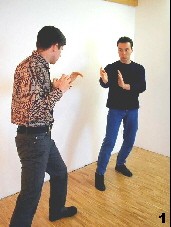 |
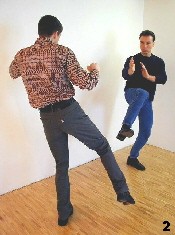 |
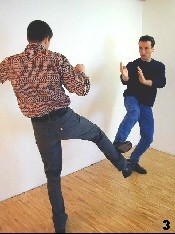 |
|
Fig. 1-3: The attacker prepares for a long distance kick. Lifting the forward leg, Sifu Dragos performs a Bong-Gerk to stop the attacker's leg. During the entire execution he maintains eye contact, in order to keep track of the attacker's actions.
|
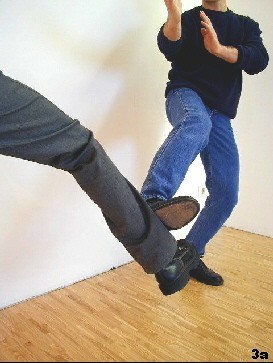 |
|
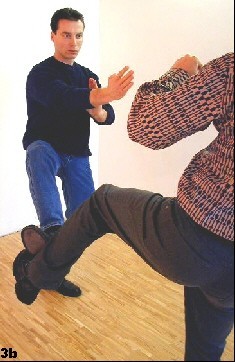
|
|
Fig. 3a+ 3b: The stop-kick is performed with the same leg used by the aggressor to attack, which increases the probability of interception. In moments of surprise or in chaotic situations, this gives us more security. If our kick misses the leg, the shin bone of our angled leg provides additional protection.
|
|
Fig. 3b: If the opponent attacks with a "low kick", we execute the "Tan-Gerk" defense, using the opposite leg in relation to the one which is attacking.
|
|
Initial Position: The attacker performs a long distance kick (his intention to kick is clear)
|
 |
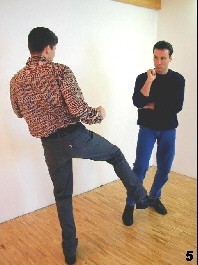 |
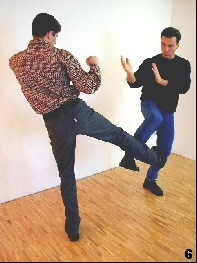 |
|
Fig. 4: The attacker approaches. Because he still hasn't shown his intention to attack, but is already at a close distance, Sifu puts his leg forward and positions his arms in an inconspicuous, but central, position.
|
|
Fig. 5+6: The attacker performs a kick to Sifu's abdomen. In an attempt to execute a stop - Sifu lifts his leg in an angle (Fig. 6a), with the Bong-Gerk technique, which intercepts the attack, neutralizing it gently, with its deformation.
|
|
 |
 |
 |
 |
|
|
 |
 |
 |
|
|
|
 |
 |
 |
| |
|
|
|
| |
|
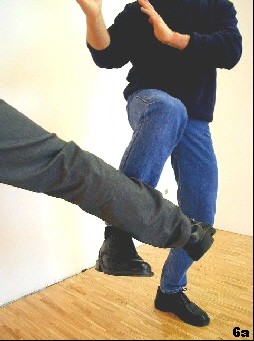 |
|
| |
|
| |
| |
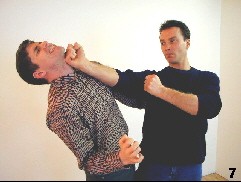 |
|
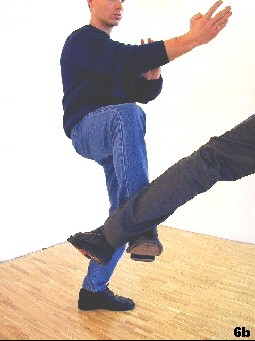 |
|
| |
|
| |
Fig. 7: After neutralizing the kick, Sifu proceeds immediately with a step forward, preparing for the counterattack. As he prepares to advance, his leg contacts the opponent's leg to prevent further attacks (Fig. 6c). His lead knee is slightly bent, crossing the attacker's tibia and applying forward pressure.
|
|
|
| |
|
|
| |
|
|
 |
| |
|
| |
|
Fig. 6b: If the kick comes from the other side, the passive Tan Gerk technique would be executed.
|
|
| |
|
| |
| |
Tip |
|
| |
| |
|
A short range attack usually occurs when we are surprised or when the situation suddenly escalated. In this scenario, It is difficult to detect if there will be an attack and how will it take place. As the attacker approaches, for safety, we must put one leg forward. A kick to the abdomen at close range can be difficult to intercept - because we have very little time to execute the stop hit. In an emergency, we make use of passive blocks for the kick, using our shin bone. For damage control here, we go by the following motto: it is better to go home with a bruised shin bone, than to take a full power kick to the abdomen. The leg shield techniques of Bong-Gerk (Fig. 6a) or Tan-Gerk (Fig. 6b) are considered passive techniques, but in this scenario they are a by-product of an attempt to perform a stop kick. Nonetheless, if we are faster than the attacker, we will execute the stop kick without major problems. Otherwise the opponent's kick will be intercepted by the Bong or Tan Gerk. In one way or another, our barrier kick will accomplish its goal.
Important: When performing a stop hit - whenever possible - use your stronger leg!
|
|
|
| |
|
Exercise 7: Stop Hit to the Hip Against a Backward Spinning Kick
CLASSICAL WING TSUN EXTENDED
Wing Tsun Lesson 2: Avoiding Kicks and Indefinite Attacks
Exercise 7: Stop Hit Against a Backward Spinning Kick
 |
 |
 |
| |
Tip
|
|
| |
| |
|
Against opponents who have good and fast kicking techniques, the kick to the pelvis is also a good strategy. Even if the kick techniques are sophisticated and difficult to assess, the defense is still easy: kick to the pelvis (after all, the legs originate there). Because the pelvis moves slowly, it is an easier target to hit. This variant can be used against any kick, regardless of whether the spinning kick is directed to the legs, trunk or head. In the above case, the conflict began when the attacker was already in a close distance. If the conflict starts with the attacker in a longer distance, instead of the pelvis, the knee of the leg which is performing the intermediate step can be the target of our interception kick.
|
|
|
|
Exercise 8: Against Step to the Side → Stop Hit to the Hip
CLASSICAL WING TSUN EXTENDED
Wing Tsun Lesson 2: Avoiding Kicks and Indefinite Attacks
Exercise 8: Against Step to the Side → Stop Hit to the Hip
|
|
 |
 |
| |
Fig. 1: The opponent stands at a distance greater than one leg length, which is why Sifu Dragos assumes a neutral stance. The attacker would have to be closer to be able to reach Sifu.
|
|
|
|
 |
 |
| |
Fig. 2+3: Sifu makes an intermediate step with his left leg to interfere with the attacker's timing and prevent him from kicking. The actual stop hit is performed with the other leg.
|
|
 |
|
| |
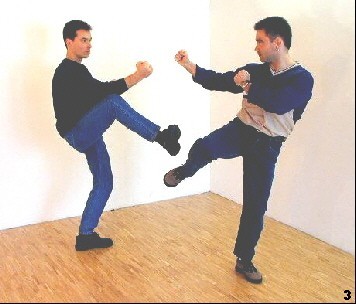 |
 |
 |
 |
 |
 |
| |
Fig. 4:
The attacker can not deliver his side kick, because Sifu's kick to his hip has already neutralized him in the beginning.
|
| |
| |
Tip
|
|
| |
| |
|
Usually, we wait for the opponent to approach within our critical distance to move toward him, protected. The execution of the first intermediate step is due to a structural disadvantage, usually invisible (the opponent can kick our leg while we move). An exception would be situations in which the opponent is clearly not prepared, is careless or inattentive. Here we can gain an advantage with a surprising approach.
The neutral starting position (IRAS stance) gives us the possibility to force the opponent to move much closer to us in order to reach us, e.g., to perform low kicks, etc. This gives the advantage of getting closer to him.
An energetic approach is a very successful strategy because it gives the opponent no time to think. This way we move to decide the combat in a few seconds.
|
|
|
|
|
Exercise 9: Counter High Kick → Stop Hit to the Hip
CLASSICAL WING TSUN EXTENDED
Wing Tsun Lesson 2: Avoiding Kicks and Indefinite Attacks
Exercise 9: Counter High Kick → Stop Hit to the Hip
Exercise 10: Dealing with Punches → Pak Sao From Outside with Leg Control Against Southpaw Stance
CLASSICAL WING TSUN EXTENDED
Wing Tsun Lesson 3: Dealing with punches - Against southpaw stance
Exercise 10: Pak-Sao/Punch from the outside with leg control
| |
|
|
If your attacks continue, the proportionality of your actions should be taken into account. The rule is: as gentle as possible, as hard as necessary. This means that you should stop, from a legal point of view, as soon as the opponent falls to the ground, and does not represent a real risk for you anymore. If you are fighting for your life, however, you have to go on until you are "safe" and, if you are in doubt, you might have to continue until the attacker is actually out of action.
|
|
Exercise 11: Basic Exercise - "Chain Punches"
CLASSICAL WING TSUN EXTENDED
Wing Tsun Lesson 3: Dealing with Punches
Exercise 11a: Fist Formation

|
|
Fig. a-d: Make a fist by first rolling in the four fingers of one hand (Fig. a and Fig. b) and finally put your thumb over middle and index fingers (Fig. c). The fist surface of attack is the knuckle of the small, the ring and the middle finger (Fig. d). These 3 knuckles are aligned for anatomical reasons and provide a large and secure area of impact. On soft body surfaces, however, the entire front surface of the fist will deliver the impact.
|
Exercise 11b: Basic Exercise "Chain-Punches"
|
 
|
 |
| |
Fig. 1:
In the initial position, advance one arm forward, through the middle of your body (Central Punch). The rear fist is close to the inside of the elbow, in front of the solar plexus and slightly lower than the arm that is stretched.
|
|
| |
| |
Fig. 2: Now, start the movement with the back fist and punch in a slightly upward movement. Once the fist is advancing to cross the forearm, we pull back the fist which is in front. The next punch crosses taking the place of the fist which was in front. The joints of the wrists thus overlap here for a fraction of a second.
|
|
| |
| |
Fig. 3: At the moment of impact, the trunk is frontally positioned (without turning), so that both arms always have the same range. Since the punch also has a protective purpose (guarding the head), the fists should always be placed in front of the center line. The hand joints have their angles adapted to the moments of impact, so that the impact surface is always facing forward.
|
|
| |
| |
Fig. 4-5: The sequence described is now repeated on the other side.
|
|
|
| |
|
|
|
Application example
|
Chain punches are amongst the most famous and best-known techniques of the WT. The front fighting stance is the most aggressive fighting strategy of all: instead of yielding defensively and assuming a protective stance in which the opponent has few possible targets, in this tactic we explore our strengths. It is similar to a Tennis game: you can play not to lose (defensively) or play to win (offensively). Due to the frontal position of the trunk and its stabilization, it is possible to execute extremely fast movement sequences (ex. 5 to 10 punches per second!). Being constantly under attack, the opponent will become irritated, panic or give up acting.
Chain punches are not used at the beginning of the defensive actions, but only after a "mid-range" distance is reached. First, we must get closer to the distance of the arms, using techniques of control and opening the opponent's guard. (see Exercise 10: Pak-Sao from outside with leg control). Thus, the first punch that strikes the opponent is usually not a chain punch, but often a strike with rotation of the trunk and simultaneous control with the other hand. A sequence of chain punches can irritate the opponent or lead him to take defensive postures - which are ideal conditions for us to shorten the distance and make use of weapons with greater potential for knockout (knees and elbows). Remember that the impact surface of the punches occurs at the bases of the last 3 knuckles.
|
Exercise 12: Lap-Sao Traps the Rear Arm
CLASSICAL WING TSUN EXTENDED
Wing Tsun Lesson 3: Dealing with punches - Against southpaw stance
Exercise 12: Lap-Sao traps the rear arm after counter-resistance
|
|
 |
|
Initial position
Fig. 1: After Sifu Dragos has managed to get close using Pak-Sao + Punch, the opponent might protect himself lifting his arm and assuming a protective stance before the punch hits him.
|
|
|
 |
 |
| |
Fig. 2+3: The hand of the opponent performing the protection continuously exerts a pushing motion to the side. Once this movement is directed to outside of the "center line", the opponent is exposed. Sifu seizes the opportunity and throws a "reverse" punch at the opponent's head. The punch replaces the "previous" punch and for this reason Sifu can draw back his arm at the same time.
|
| |
| |
Fig. 4+5: Finally, Sifu pulls the opponent's arm down with a Lap Sao; This traps the opponent's arms, and Sifu can perform a final Fak-Sao to the opponent's throat.
|
|
|
 |
 |
| |
|
The "center line" represents an imaginary straight line. It is the line that connects us to the opponent. Or, the line in which we must attack and occupy to be able to reach our target and not be hit at the same time. This can also be called "attack line occupation" e.g., the line of attack in which we must move to protect ourselves and at the same time control the opponent. I like to compare this with the medieval duel of spears: each of the knights tries to overthrow the other one of the horse, so that his spear reaches the opponent and he himself is not hit. In order to achieve such a favorable position, the opponent's arm must be deflected by the so-called "Wedge Principle" (however, this requires a sufficient force level), or by an opening technique with the hands, which paves the way for the attack to be performed (see exercise above, for an example). Another elegant strategy is: during the application of the wedge principle, we change our positions through turns, leg work and use of the elbows, altering the body weight distribution, thus acquiring a favorable lateral position without greater efforts (see also Exercise 25: External punch as a simple defense against a straight punch).
|
|
Exercise 13: Pak-Sao + Punch From Inside
CLASSICAL WING TSUN EXTENDED
Wing Tsun Lesson 3: Dealing with Punches - Against Southpaw Stance
Exercise 13: Pak-Sao + Punch from inside
Exercise 14: Basic Exercise - Chain Punches with Turning
CLASSICAL WING TSUN EXTENDED
Wing Tsun Lesson 3: Dealing with Punches
Exercise 14: Basic Exercise. Chain Punches with Turning (Displacement)
|
|
 |
 |
| |
Fig. 1: Sifu Dragos assumes the Internal Rotation Adduction Stance (IRAS) stance and keeps his arms in a position ready to apply the Chain Punches. In this position, the knees have a slight tension in the adductor muscles (one knee in relation to the other).
|
| |
| |
Fig. 2+3: Sifu completely changes his weight to the right leg while simultaneously punching with his right arm. The advancing shoulder lengthens the attack. The legs are slightly curved. The left leg presses perpendicularly to the ground and ensures the stability of the movement with a anchor or brake effect. The abdomen muscles are slightly but permanently tensioned to stabilize the trunk. In this exercise, Sifu turns at an angle of 45°. The two foot positions are parallel to each other. The trunk posture is erect, does not lean forward or back.
|
| |
| |
Fig. 4-9: The whole process now happens to the opposite side. The turn is originated by the tension of the adductor muscles. The body weight should not oscillate backwards or forwards and the trunk's movement occurs because of the hip movement and the leg work, for each side in which the turn is happening.
|
|
The turn is needed to generate impact and range and/or to escape of an attack. It can assume any angle of rotation, depending on the particular circumstances and requirements. There are passive and active turns. The former are caused by the actions of the opponent (Rotating Gate Principle) and are found in situations where contact with the opponent already exists (for example, close combat situations) and we can sense and detect pressure changes in fractions of seconds with feeling and reflex training. We use active turns, however, in situations in which we have to rely on the perception of our eyes. This, in turn, requires judgment, quick perception and experience.
|
Exercise 15: Basic Exercise - Chum-Kiu Sidestep
CLASSICAL WING TSUN EXTENDED
Wing Tsun Lesson 3: Dealing with Punches
Exercise 15: Basic Exercise - "Cham-Kiu Step"
 |
 |
| |
|
By aligning the body while the "anchor leg" presses the floor, both feet move simultaneously!
|
|
Exercise 16: Outside Lap Sao + Punch with Foot Control
CLASSICAL WING TSUN EXTENDED
Wing Tsun Lesson 3: Dealing with Punches - Against a Low Traditional Stance (Left Arm and Leg in Front)
Exercise 16: Lap-Sao + Punch From Outside with Foot Control
|
|
 |
 |
 |
 |
 |
 |
 |
 |
| |
Initial Position
Fig. 1: The attacker approaches with hostile intent and the left arm ahead and in the lower position.
|
|
| |
| |
Fig. 2 : Sifu advances and approaches the aggressor with its stronger side at the front (right), sliding along the center line toward his head.
|
|
| |
| |
Fig. 3+4 : Next, Sifu's right arm is able to freely reach its target. He controls the left arm of the opponent making a Lap-Sao with his left hand at shoulder height, pulling forward while simultaneously punching with the right hand. In this way, Sifu is able to perform a falling-step of the Chum-Kiu even more quickly. Due to this isolation action, the right arm of the opponent is, at the decisive moment, incapacitated by the force exerted on the other hand. Sifu is behind a "shadow of protection" in relation to the opponent, since the opponent's arm becomes a barrier against himself. For additional protection against kicks to the abdomen, Sifu controls the opponent's front leg using stepping technique called "Gam-Gerk" (Fig 4b).
|
|
| |
| |
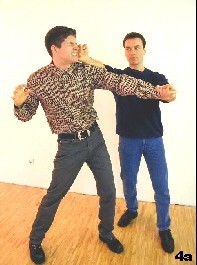 |
|
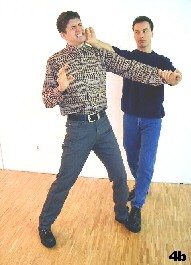 |
| |
| |
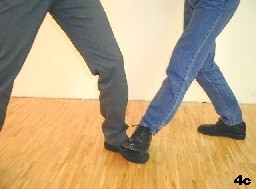
|
|
| |
| |
Fig. 4c: If Sifu had moved forward from a neutral position (IRAS) instead of the forward step posture, then the Gam-Gerk foot control would be the first one and then the step to the side (crossing step).
|
|
| |
| |
Fig. 5-7 : Finally, Sifu attacks the attacker's neck and performs an elbow attack on the opponent's head.
|
|
|
 |
 |
| |
|
As with all primary self-defense techniques, we do not have to wait until the enemy attack reaches us, but we have to face the attacker. In this way, we are not compelled to react and do not fall into the "sacrificial role" psychologically. Due to the simultaneous execution of control and a prior attack, the attacker has no possibility to execute duplicates or other strokes in succession. Already the legendary Bruce Lee recognized: "If I am faster than the attacker, I do not need (passive) defense techniques.
|
|
Exercise 17: High-Pak Sao + Fak Sao From Inside
CLASSICAL WING TSUN EXTENDED
Wing Tsun Lesson 3: Dealing with Punches - High Guard with the Left in Front
Exercise 17: High Pak-Sao + Fak-Sao From Inside
|
|
 |
 |
| |
Fig. 1: The attacker, with his left arm in front (in a high position), approaches Sifu Dragos with hostile intent.
|
|
|
|
 |
 |
 |
 |
| |
Fig. 2-3: Since the attacker's front hand is not only high, but his guard is also open, Sifu advances by executing a Fak-Sao technique. Sifu's left hand performs at the same time a Pak-Sao technique, which is intended to open and control the opponent's front hand. The right arm elbow (which executes the Fak-Sao) additionally pushes the opponent's arm out to open his guard.
|
| |
| |
Fig. 4: While performing the Fak-Sao + Pak-Sao techniques, Sifu pushes his head back. By extending the trunk, his head is protected. In addition, Sifu's forward hand movement is empowered, since the spinal erector muscles are used.
|
|
| |
| |
Fig. 5+6: Finally, Sifu executes the chain punches. Sifu's right arm recoils while controlling the opponent's forearm. During the second punch, the arm advances and executes the same type of control as it slides.
|
|
 |
 |
| |
|
Your Fak-Sao will be correct if it is capable of being used alone (without the Pak-Sao), i.e., it achieves the same effect of deflecting out the opponent's arm while also reaching his head/throat. The Pak-Sao, in the example above, is used to simplify the technique and to give additional security to the opening process.
|
|
Exercise 18: Lap-Sao + Punch to the Ribs
CLASSICAL WING TSUN EXTENDED
Wing Tsun Lesson 3: Dealing with Punches - High Guard with the Left in Front
Exercise 18: Lap-Sao + Punch to the Ribs
 |
 |
| |
Fig. 2: Sifu performs a diagonal falling-step and pulls the front arm of the opponent to the side. Sifu's strongest arm (right), at the same time, performs an attack to the ribs (vertical fist position). Due to the high position of the opponent's arms, Sifu is able to reach this area easily.
|
|
|
|
|
|
 |
 |
| |
Fig. 2a: Alternatively, the vertical fist attack can be performed with a horizontal impact position. The practitioner should experiment to see in which of both positions he/she will be able to generate more force. The decision of which punch to use here is individual and should come from experience and experimentation.
|
|
 |
 |
| |
Info
|
 |
 |
| |
|
An attack on the exposed ribs usually has a great effect, especially since this area is sensitive and vulnerable. It's also an effective technique which can irritate the opponent through pain, making him open his guard ("Door opening strategy"), allowing the use of a technique with more potential for KO (knee or elbow strikes).
|
|

Exercise 19: If the Opponent Resists - Continue with Punch + Lap-Sao
CLASSICAL WING TSUN EXTENDED
Wing Tsun Lesson 3: Dealing with Punches - High Guard with the Left in Front
Exercise 19: If the Opponent Resists - Continue with Punch + Lap-Sao
|
|
 |
 |
 |
| |
Initial Position
Fig. 1: The attacker approaches Sifu with his left arm (high) at the front. Sifu advances vigorously and applies Fak-Sao (right) and Pak-Sao (left) to open the opponent's guard and reach his head.
|
|
| |
| |
Fig. 2: The opponent reacts in time and tries to close the opening by adjusting his guard, lowering his arms.
|
|
| |
| |
Fig. 3-5: This counterbalancing movement exposes his head. Sifu seizes the opportunity and punches him in the face.
|
|
| |
| |
Fig. 6-8: Sifu can now continue to deliver another punch, while controlling the opponent's front hand with a pull, using Lap-Sao.
|
|
| |
| |
Fig. 9+10: Finally, Sifu shortens the distance pulling the opponent's neck, advancing and delivering a final elbow strike.
|
|
 |
 |
| |
|
To avoid the risk of hurting your partner's eyes while training the Fak-Sao technique, you can perform the exercise with your fists closed. In real application, however, the stretched fingers provide a gain in reach that can be decisive for victory or defeat. When practicing the techniques of elbow strikes, extreme care should also be taken. To prevent possible injury, never push your elbows directly to your partner's head, but only touch your forearm on the training partner's neck.
|
|
Exercise 20: Lap-Sao + Fak-Sao Against Force that Goes to the Side
CLASSICAL WING TSUN EXTENDED
Wing Tsun Lesson 3: Dealing with Punches - High Guard with the Left in Front
Exercise 20: Lap-Sao + Fak-Sao Against a Force that Goes to the Side
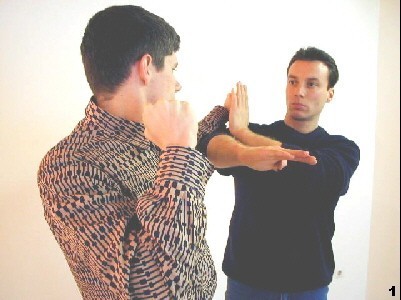 |
Initial Position
Fig. 1: The attacker approaches Sifu Dragos with the left arm (high) ahead. Sifu advances vigorously and applies Fak-Sao (right) and Pak-Sau (left) to open the opponent's guard and hit his head.
|
|
Fig. 2: The opponent defends Sifu's Fak-Sao with a block to the side. Sifu's arm is thus "loaded" with a spring force. The blocking of the opponent deforms Sifu's arm to the Bong-Sao technique - the tension in Sifu's arms becomes greater and greater.
|
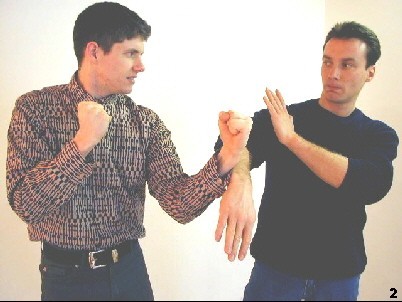 |
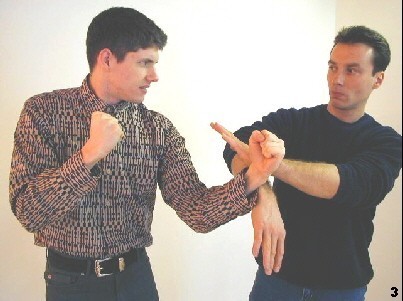 |
|
|
Fig. 3+4: Sifu now pulls the opponent's arm down, using Lap-Sao. This will clear the path, allowing his arm to explode into a Fak-Sao technique.
|
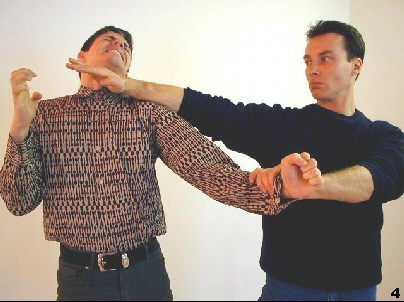 |
Exercise 21: Opening of Guard if There is Resistance, Using Lap-Sao
CLASSICAL WING TSUN EXTENDED
Wing Tsun Lesson 3: Dealing with Punches - High Guard with the Left in Front
Exercise 21: Opening of Guard if There is Resistance, Using Lap-Sao
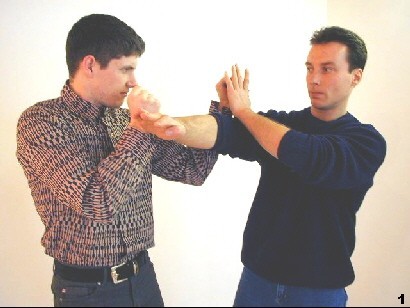 |
Initial Position
Fig. 1: Sifu Dragos advances with Pak and Fak-Sao to try to overcome the guard and reach the opponent's head, already expecting a strong posture of protection from the opponent. This results in a collision with the protection performed by the opponent's back hand, which means that Sifu's Fak-Sao can not reach its target.
|
 |
Fig. 2: Sifu uses the contact created to now pull the opponent's arm to the side, using Lap-Sao and controlling both arms. At the same time, his left arm hits the target. At the moment of pull, Sifu performs a falling-step to the left and hides like a "shadow", making it even more difficult for the opponent to reach him.
|
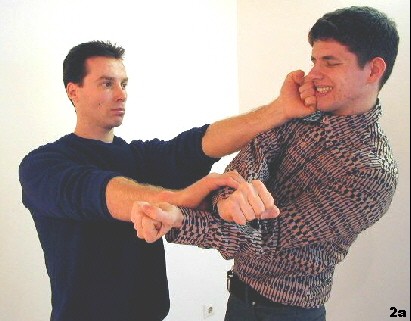 |
Fig 2a shows the same position from a different perspective. The opponent, already injured, can now be put out of action with a weapon with greater potential for K.O (elbow). Instead of a punch, the Fak-Sao technique can also be used and will more easily allow you to get around the opponent's arm.
|
CLASSICAL WING TSUN EXTENDED - Part 2: Defense Techniques
Exercise 22: Pendulum with the Upper Body for Evasion of Attacks
CLASSICAL WING TSUN EXTENDED
Wing Tsun Lesson 4: Defense against Punches
Exercise 22: Pendulum with the Upper Body → Collision Avoidance by Retreating with the Upper Body
 |
 |
| |
Fig. a-e: While swinging his trunk back, Sifu maintains eye contact with the opponent. In the initial position, the trunk is in an upright posture.
|
 |
 |
| |
|
In order to be successful in carrying out the evasive movement in potential conflict situations, an initial upright stance is necessary. During the retreat of the trunk, the head should not be thrown back, since eye contact with the opponent should be maintained at all time. In this position, the chin is pulled slightly back. With the contraction of the neck muscles, if our head is reached, there is still stability and extra protection. In order to make the total movement faster and more fluid, the strengthening and stretching of the hip flexors and abdominal muscles, as well as the strengthening of the neck muscles are recommended.
|
|
Exercise 23: Defense Against Punches → Deflection/Protective Postures Using Cham-Sao
CLASSICAL WING TSUN EXTENDED
Wing Tsun Lesson 4: Defense Against Punches
Exercise 23: Defenses Against Attacks to the Trunk → Deflection and Protective Postures Using Cham-Sao
|
Preliminary Exercise For Cham-Sao ("Sinking Arm")
|
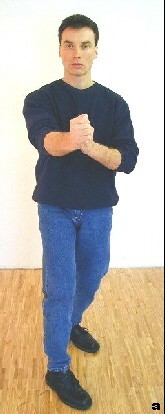 |
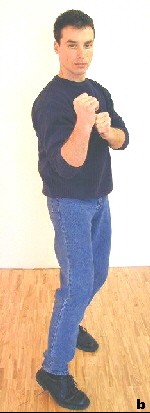 |
 |
Initial Position, Fig. a: Sifu Dragos has one leg in front. The arms are positioned in the center and front of the trunk.
|
Fig. b+c: For protection against attacks to the abdomen or chest, Sifu sinks the elbow of the arm that is positioned in front. In this case, the shoulder is moving forward. The height of the wrists remains unchanged.
|
| |
|
Example 1: Abdominal protection using reaction with Cham-Sao "diagonally inside" (right)
|
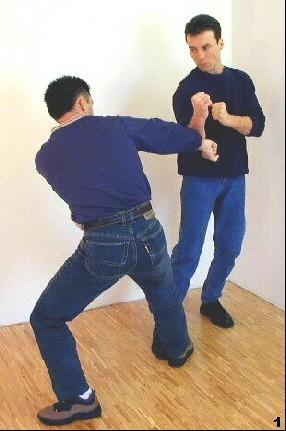 |
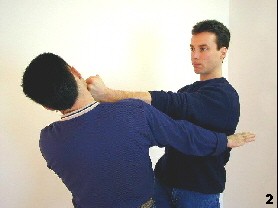 |
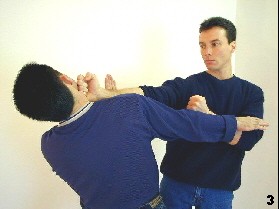 |
Fig. 1: The attacker attacks with a low punch with his right arm. Sifu rotates his shoulder slightly forward and brings his elbow slightly down. With his forearm he approaches the fist of the opponent's attacking arm. The attack is deflected down and simultaneously is guided out of reach of Sifu's body.
|
Fig. 2+3: Sifu then begins to counterattack with chain punches to the attacker's head, incapacitating him.
|
| |
|
Example 2: Abdominal Protection using reaction with Cham-Sao "in front and outside" (right)
|
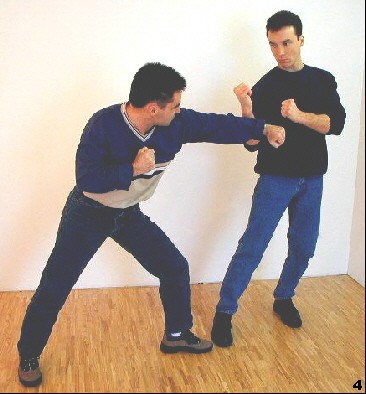 |
 |
|
Fig. 4: The attacker performs a left arm attack to Sifu's solar plexus. Again, Sifu uses the movement of Cham-Sao, in which he sinks his elbow and advances with his forearm, turning his shoulder slightly forward. The opponent's attack is then diverted out of Sifu's trunk.
|
Fig. 5: Sifu now stretches the arm which executed the Cham-Sao to attack and hits the opponent's head. More punches can follow.
|
| |
|
Example 3: Abdominal protection using reaction with Cham-Sao "diagonally inside" (left))
|
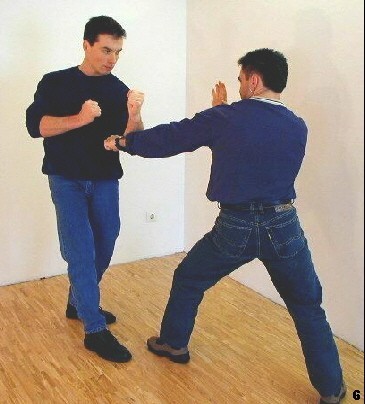 |
 |
|
Fig. 6: In this example, Sifu uses the rear hand to execute the Cham-Sao protection, frustrating the opponent's attack. Again, Sifu deflects the attacker's fist, directing his attack down and out of reach of Sifu's body.
|
Fig. 7: After the deflection with the fist, Sifu is ready to counterattack with chain punches.
|
 |
 |
| |
|
The effect of Cham-Sao ("sinking arm") in this application is similar to the hull of a ship. The punches are deflected low and to the side. In the beginning, the movement of the elbow is the same movement which would occur in a punch, with the difference that we wait a little longer (until the attacker's movement is diverted) to stretch the arm. Notice that the forearms must be in a angle greater than 90 degrees. This angle must not in any way be perpendicular or smaller than 90 degrees, with your fist directed to your own head.
|
|
Exercise 24: Simple Defense Against Punch Using Inside-Punch
CLASSICAL WING TSUN EXTENDED
Wing Tsun Lesson 4: Defense Against Punches - Deviations Using Displacements and Wedge Principle
Exercise 24: Simple Defense Against a Punch Using Inside-Punch
 |
 |
| |
Fig. 3+4: Sifu now gives a counter-attack with his left, and uses his right arm for controlling the wrist of the attacker. Sifu executes further counter-attacks, while taking a forward step. Sifu's right fist glides along the central line on the inside of the opponent's arm to hit his head.
|
 |
 |
| |
Fig. 5+6: Alternatively, a thumb attack can be used with one or both arms. Again, the attack of the opponent is diverted from our head, because of the wedge principle.
|
Exercise 25: Simple Defense Against Punch Using Outside-Punch
CLASSICAL WING TSUN EXTENDED
Wing Tsun Lesson 4: Defense Against Punches: Deviations Using Displacements and the Wedge Principle
Exercise 25: Simple Defense Against a Punch Using Outside-Punch
 |
 |
| |
Fig. 3+4: Sifu holds the opponent by the neck and applies an elbow strike. He can also perform a turn to empower his elbow strike.
|
Exercise 26: Simple Defense Against Punch Using Diagonal Inside-Punch
CLASSICAL WING TSUN EXTENDED
Wing Tsun Lesson 3: Dealing with Punches - High Guard with the Left in Front
Exercise 19: If There is Resistance to the Side - Continuation with Punch + Lap-Sao
|
|
 |
 |
 |
| |
Initial Position
Fig. 1: The attacker approaches Sifu with his left arm in front (high). Sifu approaches vigorously and tries to apply a Fak-Sao (right) and Pak-Sau (left) to open the guard of the attacker and reach his head.
|
|
| |
| |
Fig. 2: The attacker reacts in time and tries to close the space, lowering his guard, bringing his arms down.
|
|
| |
| |
Fig. 3-5: The attacker's correction movement opens the area of his head. Sifu takes advantage of the open position and punches his head.
|
|
| |
| |
Fig. 6-8: Sifu now delivers another punch, while controlling the opponent's front arm pulling with Lap-Sao.
|
|
| |
| |
Fig. 9+10: Finally, Sifu pulls the opponent by the neck and delivers a final elbow strike.
|
|
 |
 |
| |
|
To avoid the risk of hurting your partner's eyes while training the Fak-Sao technique, you can perform the exercise with your fists closed. In real application, however, the stretched fingers provide a gain in reach that can be decisive for victory or defeat. When practicing the techniques of elbow strikes, extreme care should also be taken. To prevent possible injury, never push your elbows directly to your partner's head, but only touch your forearm on the training partner's neck.
|
|
Exercise 27: Simple Defense Against a Punch Using Diagonal Outside Punch
CLASSICAL WING TSUN EXTENDED
Wing Tsun Lesson 4: Defense Against Punches - Deviations Using Displacements and Wedge Principle
Exercise 27: Simple Defense Against a Punch Using Diagonal Outside Punch (High)
 |
 |
| |
|
This procedure can be carried out in an even more elegant and economical way, even before the step forward is made, with our favorite leg (in this case, the right leg), we make a small evasive movement, taking a step to the left. This procedure is also called "zig-zag step". By moving to the left, you shift your position as your punch still moves forward. This means that the opponent's attack goes into the void without great effort.
Alternatively, you could pull yourself to the side with the help of the Lap-Sao technique, colliding with the opponent's arm from the "outside" (see Exercise 16: Outside Lap-Sao + Punch with Foot Control) to reach him with an attack or to continue with an internal punch with the left arm (Exercise 24: Simple Defense Against Punch Using Inside-Punch).
|
|
Exercise 28: Simple Defense Against a Punch Using Downward Frontal Punch from Inside
CLASSICAL WING TSUN EXTENDED
Wing Tsun Lesson 4: Defense Against Punches - Deviations Using Displacements and Wedge Principle
Exercise 28: Simple Defense Against a Punch Using Downward Frontal Punch from Inside
 |
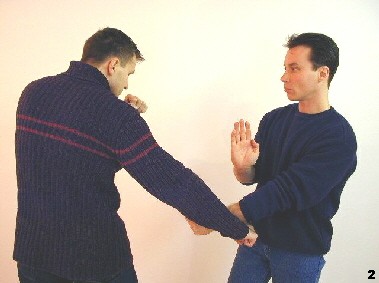 |
 |
|
Fig. 1: The opponent approaches Sifu Dragos and applies a low punch at the height of his stomach.
|
Fig. 2: Sifu uses the wedge principle and performs a downward inside punch directed at the attacker's fist, deflecting his attack. Sifu's back hand goes to a central protective position to provide additional protection as well as to prepare for quick action sequences, if necessary.
|
Fig. 3: Sifu executes a counterattack to the attacker's head with his right hand. At the same time, he performs a turn to increase the reach and impact of the attack.
|
 |
 |
| |
|
In applying the wedge principle, the attack of the aggressor is diverted, at an angle that does not allow him to hit us, by our technique that goes against his. It is similar to the water that goes against the hull of a ship in the sea. The use of the wedge principle is one of the simplest defense procedures to deal with punching (and also kicking) attacks. Although the principle of economy of movement (simultaneous attack and defense) is not being applied in the variants where the "arms are crossing", the strength of the wedge principle techniques is to be extremely simple and easy to apply in different situations. Finally, chain punches are among the most important, and best executed, techniques by most WT practitioners. Being true to the "less is more" principle, this reaction brings advantages in terms of time for implementing a counterattack.
|
|
Exercise 29: Simple Defense Against a Punch Using Diagonal Downward Punch from Outside
CLASSICAL WING TSUN EXTENDED
Wing Tsun Lesson 4: Defense Against Punches - Deviations Using Displacements and Wedge Principle
Exercise 29: Simple Defense Against a Punch Using Diagonal Downward Punch from Outside
 |
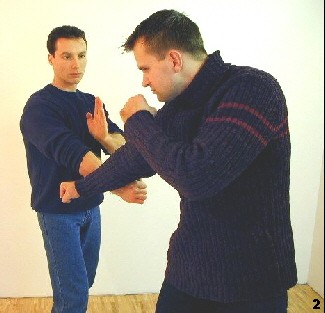 |
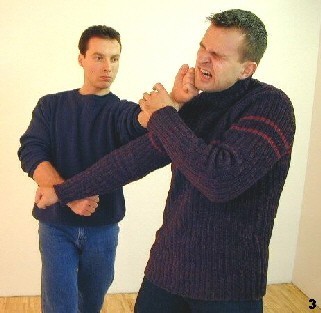 |
|
Fig. 1+2: The opponent tries to punch Sifus Dragos' stomach. Sifu, using the wedge principle, performs a low diagonal punch on the outside to the attacker's fist, deflecting his attack. Sifu's rear hand assumes a central protective position (Wu-Sao) in order to be quickly used in later actions and provide additional protection.
|
Fig. 3: Sifu now performs several chain punches to the attacker's head. Completion of the situation can be accomplished by a subsequent elbow strike.
|
Exercise 30: Simultaneous Defense With Tan-Sao + Punch
CLASSICAL WING TSUN EXTENDED
Wing Tsun Lesson 4: Defense Against Punch Using Simultaneous Defense and Attack
Exercise 30: Defense Against Punch using Simultaneous Tan-Sao + Punch
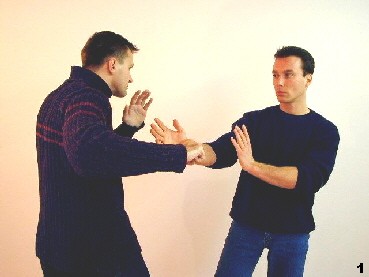 |
 |
|
Fig. 1: The opponent approaches Sifu Dragos to execute a right-hand roundhouse punch to his head.
|
Fig. 2: Sifu directs his right arm in Tan-Sao towards the opponent's fist. At the same time, his right arm performs an attack on the opponent's head. Tan-Sao's forward movement deflects the opponent's attack and takes away its effectiveness.
|
|

|
|
|
Fig. 3: Sifu then unleashes other counter-attacks to the head of the aggressor.
|
|
 |
 |
| |
|
In this example, the principle of economy of movement is used: simultaneous defense and attack. Through this mode of operation, we achieve a structural advantage over the opponent, since the attack and the defense are executed at the same time. The simultaneous attack and defense has the advantage that the opponent is not able to "use feints" or perform multiple attacks, because our counterattack already reaches him at the moment of our first contact.
The Tan-Sao in the above example can be executed in two ways: 1. Forward - In this case the wedge principle is used: the attack slips by the advancement of the Tan-Sao and loses its effectiveness. 2. Backwards - Here a principle of use of force of WT is used: "Add your strength to the strength of the opponent". In the case where the Tan-Sao is used "retreating" the arm, it redirects the attack out of our body immediately after it contacts the limb. However, exceptional speed, timing and coordination are required for this.
As a general rule, the Tan-Sao, when stretched in front of our body (e.g., from the "Man-Sao" position), deviates as it moves backward. However, if the arm is close to the body (e.g., coming from a Wu-Sao position), the Tan-Sao will be projected forward, in continuous opposition to the attack, in order to divert it.
|
|
 |
 |
| |
|
Exercise 31: Simultaneous Defense With Gan-Sao + Punch
CLASSICAL WING TSUN EXTENDED
Wing Tsun Lesson 4: Defense Against Punch Using Simultaneous Defense and Attack
Exercise 31: Defense Against Punch using Gan-Sao + Punch
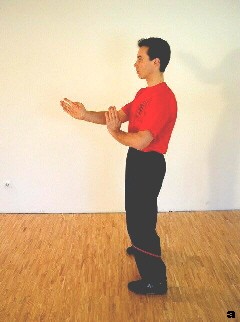 |
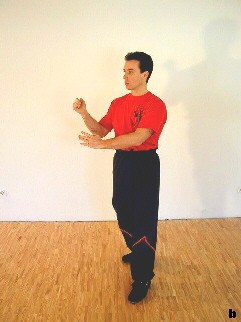 |
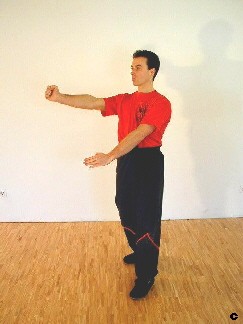 |
|
Fig. a: Sifu Dragos is in a frontal and neutral position (IRAS) and holds the arms in a central position, in front of the body. The guard position has a hand in front, Man-Sao ("Asking Hand"), and a hand in back, Wu-Sao ("Protecting Hand")..
|
Fig. b+c: Sifu transfers body weight to his right leg while simultaneously performing Gan-Sau ("Cutting Hand") with his left hand and a punch with his right hand. He holds tension between the knees and presses the leg which has no weight in it (left) against the ground, stabilizing the turn position (anchor principle). His head moves slightly backward, because of the extension of the trunk. As a result, his head becomes even more protected.
|
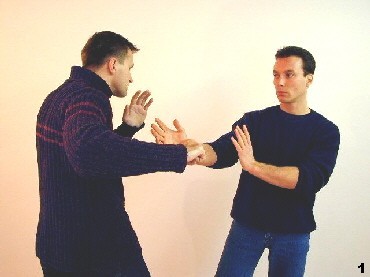 |
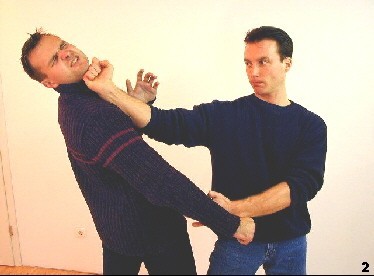 |
|
Fig. 1+2: The opponent approaches Sifu and prepares to deliver a low punch to his abdomen. Sifu perform Gan-Sao to the attacker's forearm, so that at the same time that he deviates the punch, he causes damage to the arm. Simultaneously Sifu's counterattack hits the attacker's head. The range and the strength of Sifu punch are empowered by his turn.
|
 |
 |
 |
 |
| |
Info
|
|
| |
| |
|
The Gan-Sao technique has a "cutting" nature. The attacking arm of the opponent is thus "cut" like a guillotine, which is aimed to cause him pain by his own movement. However, the Gan-Sao's main purpose is to redirect the force of the attack down and out of our body. A trunk rotation is always performed when we apply this technique, which produces a "pulling effect" on the opponent, which is drawn toward our attacking hand.
|
|
| |
| |
|
|
Exercise 32: Simultaneous Defense With Fook-Sao + Punch
CLASSICAL WING TSUN EXTENDED
Wing Tsun Lesson 4: Defense Against Punch Using Simultaneous Defense and Attack
Exercise 32: Defense Against Punch using Fook-Sao + Punch
 |
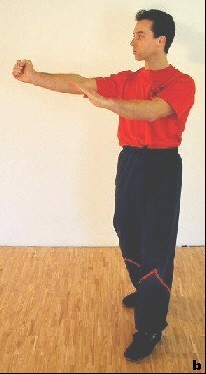 |
Fig. a: Sifu Dragos is in a frontal and neutral position (IRAS) and holds the arms in a central position, in front of the body. The guard position has a hand in front, Man-Sao ("Asking Hand"), and a hand in back, Wu-Sao ("Protecting Hand").
Fig. b: Sifu transfers his body weight to his right leg and simultaneously performs a Fook-Sao ("Hidding Hand", or "Resting Hand"). In this movement, the elbow is kept slightly lower than the wrist and the arm moves forward (going against the attack).
|
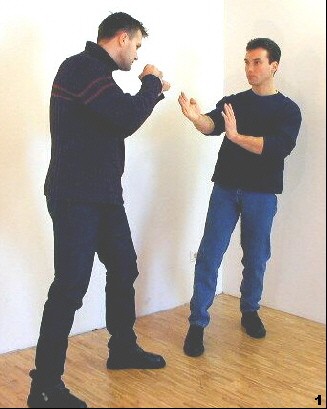 |
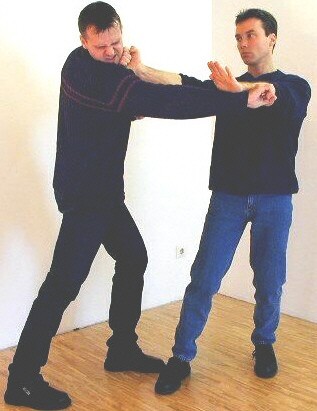
|
|
Fig. 1: Sifu is in the forward step position (one of the legs in front). The attacker attempts to punch Sifu Dragos with a right hand roundhouse punch.
|
Fig. 2: Sifu takes a step forward and simultaneously executes a punch to the opponent's head while his left hand intercepts the opponent's attack using Fook-Sao.
|
| |
| |
| |
Info
|
|
| |
| |
|
The forward Fok-Sao is more easily executed than the Tan-Sao movement (see Exercise 30: Simultaneous Defense with Tan-Sao + Punch), especially because the palm is already facing down. The Tan-Sao and Fok-Sao have an equal and interchangeable effect as forward defense movements. However, the Fok-Sao offers the possibility of exercising control over the opponent's arm after deflecting an attack. By adapting to the opponent's arm structure, a strong and flexible connection is created. This is made possible, in particular, by bending of the wrist (Huen-Got-Sao technique). An example of this can be seen in part 3 of the Siu Nim Tao form.
|
|
|
| |
| |
|
|
|
|
Exercise 33: Simultaneous Defense With Gam-Sao + Punch
CLASSICAL WING TSUN EXTENDED
Wing Tsun Lesson 4: Defense Against Punch Using Simultaneous Defense and Attack
Exercise 33: Defense Against Punch using Gam-Sao + Punch
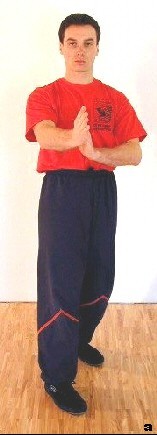 |
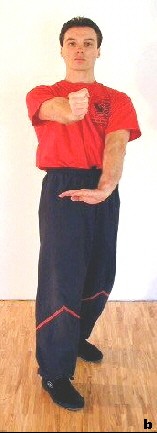 |
Fig. a+b: Sifu Dragos is in a frontal position with one of the legs in front. His arms assume a centralized position with Man-Sao/Wu-Sao. While performing a Gam-Sao with his left hand, he keeps his trunk straight and throws his head slightly back. At the same time, he perform a central punch with the right hand.
|
 |
 |
| |
|
Gam-Sao is an alternative to Gan-Sao (see Exercise 31: Simultaneous Defense with Gan-Sao + Punch) and means something like the "Pressing Hand". Execute the Gam-Sao, in the application, always diverting the attack arm out of your own body. In this way, the collision is avoided and it will be possible, in case you have inferiority of force, to repel the attack easily.
|
|
Exercise 34: Simultaneous Defense With High Internal Pak-Sao + Fak-Sao
CLASSICAL WING TSUN EXTENDED
Wing Tsun Lesson 4: Defense Against Punch Using Simultaneous Defense and Attack
Exercise 34: Defense Against Punch using High Inside-Pak + Fak-Sao
 |
Fig. a: Fak-Sao is a movement directed to the side where a large surface (from the shoulder to the fingertips) can be used to attack. In this example, Sifu Dragos simultaneously executes a Fak-Sao with a High Pak-Sao. When performing the Fak-Sao movement, the hand joints (including the wrist) are completely relaxed, giving a "whip" effect to the entire impact area. The great impact force and the "vibrating" fingertips are able to virtually overcome the blocks and hit the opponent's face, attacking as if "turning a corner". This highly dangerous technique is contained in the BiuTze form.
|
|
Fig. 1+2: The opponent moves forward with a straight punch to Sifu's head. Sifu takes a step forward with his right leg and executes a Fak-Sao with his right arm at the head of the aggressor. The High Pak-Sao is executed simultaneously to help in the "opening" of the opponent's attacking arm and, at the same time, protect Sifu's head. In order for the Fak-Sao movement to develop all of its protection and attacking characteristics, a step forward must be performed to reduce the distance in relation to the opponent.
|
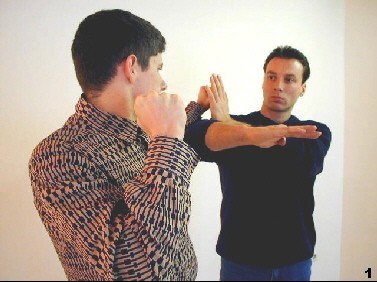 |
 |
 |
 |
| |
Tip
|
 |
 |
| |
|
When training this technique with a partner, prefer to apply a closed backhand punch instead of using the edge of your hands or fingertips, to avoid hurting your partner. Alternatively, use a proper headgear to apply this technique with its full potential. In this case, perform the technique as demonstrated above. The Fak-Sao (or backhand) will be correct when it is able to "open" the attacker's arms, even without the Pak-Sao. The Pak-Sao, in this case, will merely facilitate the opening of the opponent's front hand and will provide additional protection.
|
|
Exercise 35: Simultaneous Defense With High Outside Pak-Sao + Inside Punch
CLASSICAL WING TSUN EXTENDED
Wing Tsun Lesson 4: Defense Against Punch Using Simultaneous Defense and Attack
Exercise 35: Defense Against Punch using High Outside-Pak + Inside Punch
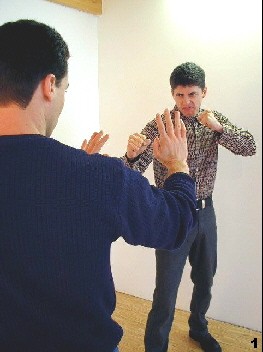 |
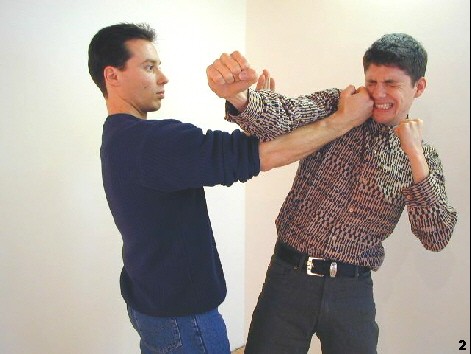 |
| Fig. 1+2: The opponent moves towards Sifu Dragos and performs a straight punch with the right hand to his head. Sifu guides the opponent's arm to the side with a Pak-Sao movement. Simultaneously, he attacks from under the opponent's arms, and hits his head. |
| |
|
|
|
|
|
| Tip |
|
|
|
|
|
Execute the Pak-Sao and the punch simultaneously. The Pak-Sao should ideally contact the arm behind the elbow joint or proximal to it (closer to the shoulder). Instead of a punch, other types of hand position can also be used for the attack, such as an attack with the thumb to the eye or a Chang-Sao ("Spade Hand"). (see Exercise 10: Pak-Sao from Outside with Leg Control Against Southpaw Stance, Fig. 4a and 4b, for more details on these attacking techniques).
|
Exercise 36: Two-Level Protection - Defense With Scissors Gan-Sao
CLASSICAL WING TSUN EXTENDED
Wing Tsun Lesson 4: Reduction of Reaction Time Using Multiple Levels Protection
Exercise 36: Two-Level Protection - Defense With Scissors Gan-Sao
 |
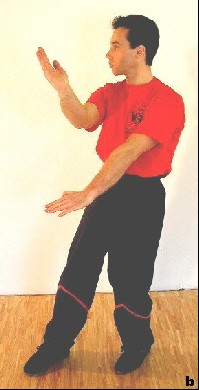 |
Fig. a+b: From the frontal position, Sifu performs a slight rotation to one side. During the "Scissors Gan-Sao" his arms "cut" the low and high levels (it crosses, and thus intercepts, the attack).
|
 |
| Fig. 1: It is difficult to predict the actions of the opponent, because he makes "feints" when attacking us. Sifu Dragos decides to apply the Scissors Gan-Sao technique. |
 |
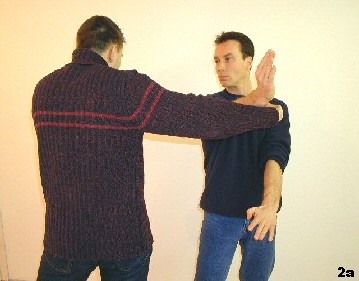 |
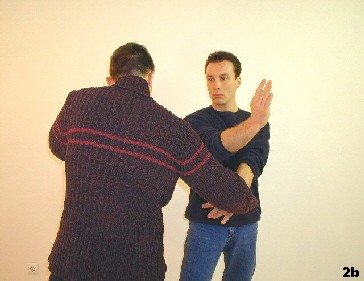 |
| Fig. 2a: The opponent punches Sifu in the head. In that case, the high hand of Sifu's Scissors Gan-Sao intercepts the attack. So he directs the High Gan-Sao toward the attacker's wrist and thus - due to better arm lever - is able to get the greatest power potential. |
Fig. 2b: In this example, the opponent punches Sifu's stomach. The lower hand of Sifu's Scissors Gan-Sao redirects the attack down and back, deflecting it away from his body.
|
 |
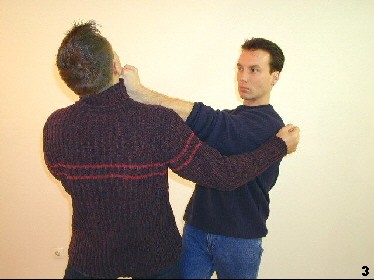 |
|
Fig. 3: Immediately after the defense of the first attack of the opponent, Sifu attacks with chain punches to the opponent's head.
|
 |
 |
| |
Info
|
 |
 |
| |
|
By using Scissors Gan-Sao, we shorten the response time required for defense. For comparison: when we use Tan- or Gan-Sao, there are 4 reaction options (upper: right and left and lower, right and left). So when we fully protect one side using the Scissors Gan, we reduce the number of choices to 2 (left or right). With the simultaneous protection of two levels, however, we give up the possibility of executing a defense and attack at the same time. The Scissors Gan-Sao is a very effective way to deal with inevitable kicks directed to the trunk. Large attack forces can be partially divided between the two arms and, thus, can be administered more easily (see Exercise 37: Defense Against Kicks Using the Arms - Scissors Gan-Sao and Lifting Using Lau-Sao).
|
|

Exercise 37: Defense Against Kicks Using the Arms - Scissors Gan-Sao and Lifting Using Lau-Sao
CLASSICAL WING TSUN EXTENDED
Wing Tsun Lesson 5: Defense Against Kicks Using the Arms
Exercise 37: Scissors Gan-Sao and Lifting Using Lau-Sao
 |
 |
 |
| |
Fig. 4: After protecting himself from the attack, Sifu catches the attacker's leg with Lau-Sao and raises his arm. Simultaneously, the Fak-Sao with the right arm hits the neck of the opponent. By having his leg lifted, the opponent loses his balance.
|
| |
| |
Info
|
|
|
|
 |
 |
| |
|
Perform the Lau-Sao technique to "catch" the opponent's leg only when the kick is performed above the height of your elbow. Otherwise, dispense the catching movement and proceed using chain punches to the opponent's head.
|
|
Exercise 38: Defense Against Kicks Using the Arms - Protection Coverage Using Kwan-Sao
CLASSICAL WING TSUN EXTENDED
Wing Tsun Lesson 5: Defense Against Kicks Using the Arms
Exercise 38: Defensive Posture Using Kwan-Sao
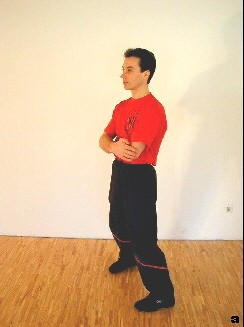 |
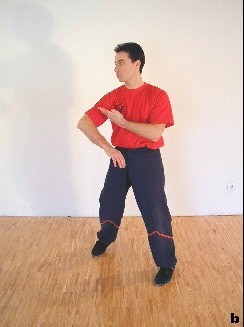 |
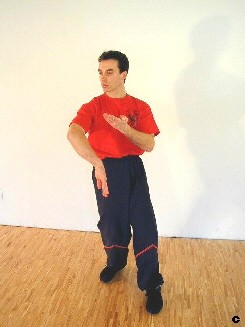 |
|
Fig. a-c: Sifu Dragos is in a neutral position. He executes a 45 degrees turn and a falling step forward. His arms execute the Kwan-Sao movement ("Rotating Arms"). In the final position, the upper arm is in the Tan-Sao position and the lower arm in the Bong-Sao position.
|
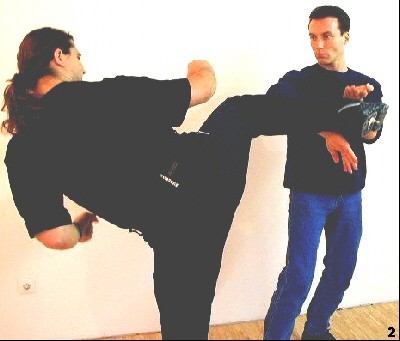 |
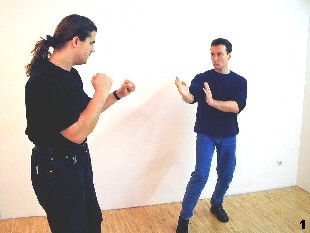 |
|
Fig. 1+2: The attacker kicks Sifu in the head. Sifu aligns his trunk with the attack and here executes a Kwan-Sao. The kick is, thus, intercepted.
|
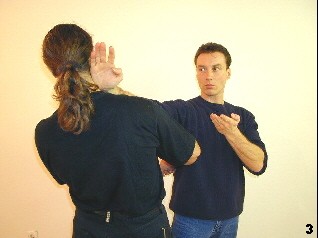 |
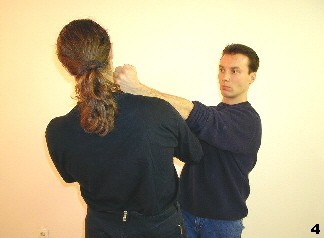 |
|
Fig. 3: Sifu makes use of the "loading" of his arm in Bong-Sao by the opponent's kicking force and converts that tension by turning his Bong into a Fak-Sao.
|
Fig. 4: Finally, Sifu executes chain punches, ending the situation.
|
| |
|
|
|
|
|
| Info |
|
|
|
|
|
The Kwan-Sao is a spring and absorption movement. In the above example, the kicking force is manageable because it is divided between the two arms of the defender. Alternatively, a turn to the side could be used, which would make the kick miss the target. The Kwan-Sao would be even more economical with the additional execution of a low side kick, targeting the opponent's supporting leg.
|
Exercise 39: Defense Against Elbow Attack - Anticipation Using Kap-Jarn Elbow Technique
CLASSICAL WING TSUN EXTENDED
Wing Tsun Lesson 6: Defense Against Elbow
Exercise 39: Anticipation Using Kap-Jarn Elbow Technique
 |
 |
| |
Fig. 3+3a: Sifu hits the opponent's head and sternum with a single movement. While the opponent attacks, even approaching very quickly and dangerously with an elbow, this solution offers the best protection and will lead to immediate results. The Kap-Jarn, during its execution, obstructs for a brief moment Sifu's field of vision, but is able to deflect any type of attack due to the wedge shape of the forearm in this position.
|
 |
 |
 |
 |
| |
Info
|
|
| |
| |
|
The Kap-Jarn elbow technique is present in the BiuTze form (pronounced "Biudschi"). The form includes not only dangerous finger strike and elbow techniques, but especially emergency solutions that allow us to neutralize an opponent, even when their attack is almost overtaking us. Make use of gravity when executing the Kap-Jarn by slightly bending the knees in the downward motion. Throw your head back and keep your torso upright. The fist is completely relaxed during the execution and the back of the hand is accommodated in the chest, at the height of the solar plexus, to ensure maximum mobility.
|
|
| |
| |
|
|
Exercise 40: Defense Against Knee Attack Using Downward Elbow
CLASSICAL WING TSUN EXTENDED
Wing Tsun Lesson 7: Defense Against Knee Attacks
Exercise 40: Use of Downward Elbows and Hook Punch
Preliminary Exercise
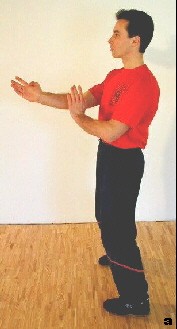 |
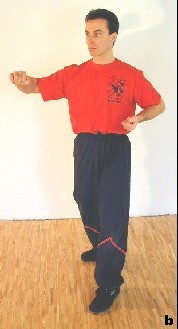 |
 |
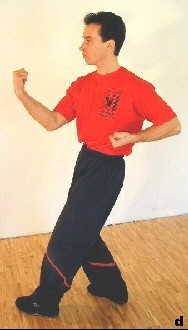 |
| Fig. a-c: Sifu performs a hook from the neutral position, turning 90° to one side. Unlike the straight punch, where the triceps has predominant impact force generation, the source of force during the execution of hooks and uppecuts is on the chest, biceps and hips (Fig.d). It is a circular movement of opposing forces (pull with the left and push with the right and vice-versa). Horizontal hooks and uppercuts, in principle, are the same movement, however with different angles of impact and wrist positions. During the execution of the uppercut, the impact surface of the wrist is aligned or curved according to each situation (see Fig. d). |
 |
 |
| |
|
Horizontal hooks and uppercuts are "passing" techniques that help us to overcome the opponent's guard.
|
|
Exercise 41: Release of Hand Against Double Frontal Grip in High Position
CLASSICAL WING TSUN EXTENDED
Wing Tsun Lesson 8: Release of Hand Against Grips
Exercise 41: Release of Hand Against Double Frontal Grip in High Position → Release Using "Kwai-Jarn" (Diagonal Elbow)
|
|
 |
|
| |
 |
| |
| |
Fig. 5: Sifu pulls the opponent down by the neck with the help of his body weight and performs a knee attack to the abdomen.
|
| |
| |
Fig. 6: Due to the knee attack, the opponent has a protective reflex and projects his head forward (Fig. 5) - precisely at that moment, Sifu strikes him with an upward diagonal elbow attack.
|
|
Exercise 42: Release of Hand Against Double Frontal Grip in Low Position (Firm Grip)
CLASSICAL WING TSUN EXTENDED
Wing Tsun Lesson 8: Release of Hand Against Grips
Exercise 42: Release of Hand Against Double Frontal Grip in Low Position (Firm Grip) Using Kwai-Jarn and Grip
Fig. 1: The opponent holds the Sifu Dragos by the wrists.
|
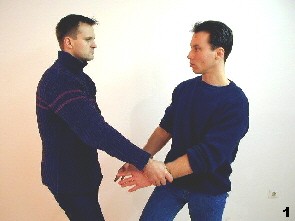 |
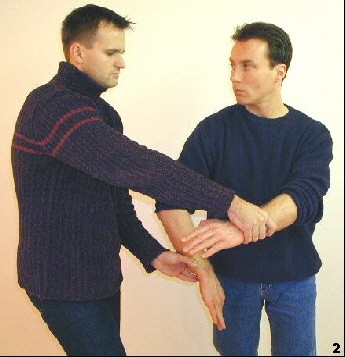 |
Fig. 2: Sifu performs a small turn and executes a low Bong-Sao. A small "sinking" motion with his own fist causes the remaining part of his forearm to settle over the fist of the opponent. The lever of this rotation movement releases the opponent's grip.
|
|
Fig. 3: Finally, Sifu applies a diagonal Fak-Sao to the opponent's neck. Since the opponent has made the grip with his hands close to each other, Sifu makes use of this and holds, with his left hand, the left arm of the opponent. As the whole process happens very quickly, the opponent does not realize that he basically immobilized himself.
|
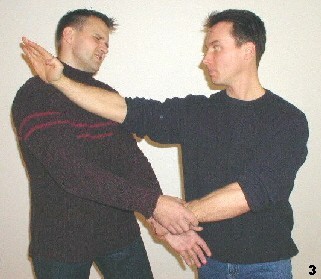 |
Exercise 43: Release of Hand Against Double Frontal Grip in Low Position (Firm Grip with Arms Spread Apart) Variant 1
CLASSICAL WING TSUN EXTENDED
Wing Tsun Lesson 8: Release of Hand Against Grips
Exercise 43: Release of Hand Against Double Frontal Grip in Low Position (Firm Grip with Arms Spread Apart) Using Kwai-Jarn and Fak-Sao
 |
 |
| |
|
Instead of attacking the opponent's neck, the clavicle can also be a target. In an emergency, this may make sense, because if this bone eventually breaks, one of the opponent's arms will be rendered useless. This is due to the fact that the clavicle is an important part of the shoulder joint complex.
|
|
Exercise 44: Release of Hand Against Double Frontal Grip in Low Position (Firm Grip with Arms Spread Apart) Variant 2
CLASSICAL WING TSUN EXTENDED
Wing Tsun Lesson 8: Release of Hand Against Grips
Exercise 44: Release of Hands Against Double Frontal Grip in Low Position (Firm Grip with Arms Spread Apart) Using Kwan-Sao
|
|
 |
 |
|
| |
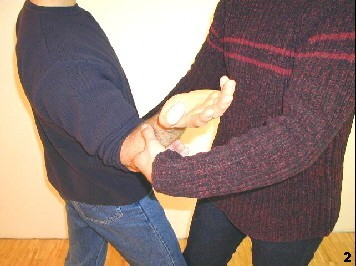 |
| |
| |
Fig. 2: Sifu uses the Kwan-Sao movement ("Rotating Arm") from the Siu Nim Tao Form to get rid of the grip. He sinks his elbows and holds the palm up. Simultaneously he advances his forearm toward the opponent's head.
|
| |
Tip
|
|
| |
|
|
|
This release can happen more easily if it is applied at the beginning of the grip. The Kwan-Sao movement is performed by making a small circle around the opponent's forearm.
|
|
|
Exercise 45: Release of Hand Against Double Frontal Grip in Low Position Using Stamping Kick
CLASSICAL WING TSUN EXTENDED
Wing Tsun Lesson 8: Release of Hand Against Grips
Exercise 45: Release of Hand Against Double Frontal Grip in Low Position Using a Stamp Kick
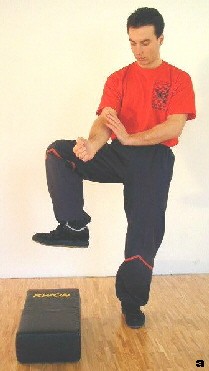 |
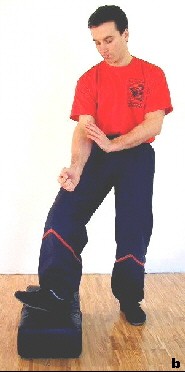 |
Fig. a+b: To execute the Gam-Gerk kick, Sifu raises his leg. At the time of the kick, he slightly bends the knee of his supporting leg to empower him with the force of gravity. The impact surface is the heel.
|
Preliminary Exercise
| Tip |
|
|
|
|
|
| The choice between hand or leg techniques to get rid of an opponent's grip involves many variables. The simplest and fastest solution is always the best. Depending on the strength of the opponent or the distance between the grips, the solutions will be different. Freeing yourself using only hand techniques is a quick and difficult approach to anticipate, but requires greater skill. If the opponent is moving in our direction during the grip, the use of a leg technique also becomes more difficult. |
Exercise 46: Release of Hand Against Double Frontal Grip Using Kick in the Genitals + Elbow and Knee
CLASSICAL WING TSUN EXTENDED
Wing Tsun Lesson 8: Release of Hand Against Grips
Exercise 46: Release of Hand Against Double Frontal Grip → Kick or Knee to the Genitals + Elbow
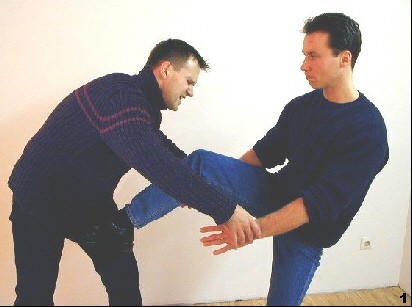 |
Fig. 1: The attacker holds Sifu Dragos' arms frontally. Sifu executes a quick kick to the genitals.
|
|
Fig. 1a: Because of pain, the opponent has less strength in his grip. Sifu performs a final elbow strike to the opponent's head,
|
 |
 |
Fig. 1b: In short distance, a knee attack can be used, rather than a kick. This is especially advisable if the opponent is pulling you to him.
|
| |
|
|
|
|
|
| Info |
|
|
|
|
|
A snapping kick with the back of the foot, with the shin or a knee attack have the same motion in principle and no distinction between these types of attacks must be made. The distance to the opponent will, thus, determine the ultimate impact area.
|
Exercise 47: Release of Hands Against Grip of Two Attackers
CLASSICAL WING TSUN EXTENDED
Wing Tsun Lesson 8: Release of Hand Against Grips
Exercise 47: Release of Hands Against Grip of Two Attackers
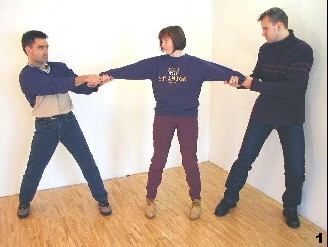 |
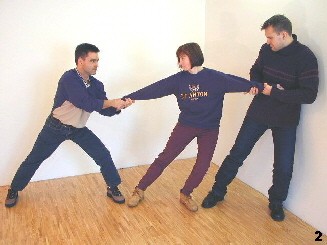 |
|
Fig. 1: Two attackers hold and pull both of Sybille's arms.
|
Fig. 2+3: Since Sybille is unable to compete against the strength of two men, she uses her leg strength and gravity to bring the two attackers close to her.
|
 |
 |
|
Fig. 3: By the approximation of one of the opponents, there is less tension from his arms, which gives more mobility to Sybille's trunk. Sybille initiates a kick.
|
Fig. 4: The opponent who was brought closer will be hit in the ribs at the time of approximation. Because he is holding Sybille's arm, the attacker's ribs are unprotected and the kick hits the target without any problem.
|
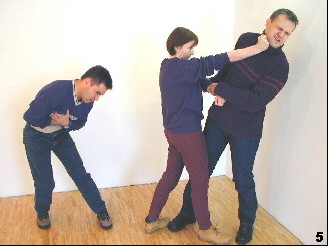 |
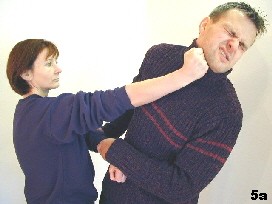 |
|
Fig. 5+5a: Because of the pain, caused by the kick, the attacker lets go of his grip. This now allows Sybille to deal with the opponent who is still holding her other arm. She turns to him and punches him in the face. In the example illustrated here, the situation is not over yet, as it was illustrated only up to the first freeing of the hand.
|
 |
 |
 |
 |
| |
Tip
|
|
| |
| |
|
In this solution, good balance and fast kicking technique are required. Try different types of targets and kicks (back kick, side kick, stamp kick, etc). Lower targets such as the knees and ankles are actually easier to hit, but reaching them will be more difficult and more flexibility will be needed.
|
|
| |
| |
|
|
Exercise 48: Defense Against Leg Grabbing, Variant 1 (Grip in the Heel)
CLASSICAL WING TSUN EXTENDED
Wing Tsun Lesson 9: Liberation Against Grip in the Legs
Exercise 48: Liberation Against Grip at the Foot → Use of Neck Pull and Knee Attack to the Head
 |
 |
| |
Fig. 2: Sifu immediately grabs the opponent's head and pulls himself toward him. To prevent the opponent from continuing to lift his leg, Sifu executes a small jump forward, rising up on the tips of the toes of his supporting leg.
|
|
|
|
|
|
| |
Fig. 3: Sifu uses the force of gravity to pull the opponent's neck down, toward his knee. The knee attack is empowered by the forward acceleration, proportioned by the jump.
|
|
 |
 |
| |
Tip
|
 |
 |
| |
|
The same solution would be used if the opponent had stepped back instead. In general, in situations where the attacker is holding us by a leg, we immediately reach for his head. In the event of being knocked to the ground, we can "drag the opponent down" with us. If we manage to keep our balance, this grip will, above all, grant us stability while we stand. To ensure that the knee reaches the head of the opponent, we must raise it as much as possible, which also optimizes the momentum of the attack, empowered by grip of the head. As a last detail, a small turning of the opponent's head is also important.
|
|
Exercise 49: Defense Against Leg Grabbing, Variant 2 (High Grip, Close to your Knee)
CLASSICAL WING TSUN EXTENDED
Wing Tsun Lesson 9: Liberation Against Grip in the Legs
Exercise 49: Liberation Against a Leg Grip Closer to the Knee → Use of Neck Grab and Elbow Strike
|
|
 |
 |
| |
|
If the opponent moves his arms away, letting go of the leg grip, you can hold him by the arms. With the difference in reach, rather than an elbow attack, a punch to the head can be performed.
|
|
|
Exercise 50: Defense Against Clinch from Behind
CLASSICAL WING TSUN EXTENDED
Wing Tsun Lesson 10: Defense Against Clinches
Exercise 50: Defense Against a Clinch from Behind → Distract Causing Pain and Free From the Clinch with Gam-Sao
 |
 |
| |
Initial Position
Fig. 1: The attacker grabs Sifu Dragos from behind, trapping his arms.
|
|
|
 |
 |
| |
Options
Step 1: Distraction by Pain
To make the attacker loosen the grip and distract him briefly, there are several possibilities::
|
|
|
 |
 |
|
 |
 |
| |
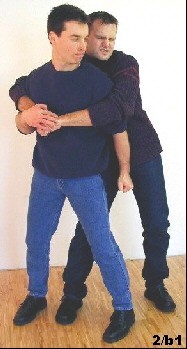 |
| |
| |
Fig. 2/b1: Sifu move his hips to the side and executes a "hammer blow" to the genitals of the opponent.
|
| |
Fig. 2/a1 and 2/a2: Sifu performs a "stamp kick" with Gam-Gerk in the opponent's foot.
|
|
|
 |

|
| |
Continuation
Step 2: Opening of the grip and orientation to the opponent
|
|
 |
|
 |
 |
| |
 |
| |
| |
Fig. 2/c1: Sifu is able to feel that the attacker's head is very close: an ideal condition to perform a backward head butt.
|
|
| |
| |
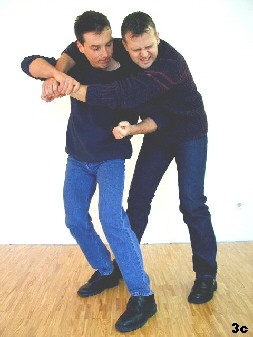 |
|
 |
 |
| |
Fig. 3a-3c: Sifu performs a double Gam-Sao movement to free from the clinch. If the opponent's grip is still partially trapping Sifu's arms, they offer support for a backward elbow attack. Sifu bends his knees a little to be able to reach the area of the opponent's bladder.
|
Exercise 51: Defense Against Clinch from Behind (with Lifting)
CLASSICAL WING TSUN EXTENDED
Wing Tsun Lesson 10: Defense Against Clinches
Exercise 51: Defense Against a Clinch from Behind → Stabilization with Inside Hook and Attack to the Genitals with the Heel
 |
 |
| |
Fig. 2: Sifu notices that he is being lifted. Immediately he uses a Huen-Gerk technique ("Circular Leg Movement") to cling to one of the opponent's legs. Thus the lifting action is hampered and Sifu's position is stabilized.
|
|
|
|
 |
 |
| |
Tip
|
 |
 |
| |
|
If the opponent manages to lift you, the options of action are limited. This is because our weapons are oriented primarily forward. If the opponent can get you up without you being able to make an attack on his genitals, the option is to hold on to his arms to mitigate the effect of his action and to "drag" him to the ground with you. Most likely a fight situation on the ground will happen from then on.
|
|
Exercise 52: Defense Against Clinch from the Front
CLASSICAL WING TSUN EXTENDED
Wing Tsun Lesson 10: Defense Against Clinches
Exercise 52: Defense Against Clinches From the Front → Attack with Thumbs to the Eyes or Knee to the Genitals
 |
 |
 |
|
Fig. 1: The attacker managed to clinch Sifu Dragos frontally and trying to take him to the ground by pressing forward.
|
|
Fig. 1b: As he grabs with both arms from the front, the attacker opens his arms at some point. In this way, a direct head attack is possible. E.g: Double attack with the thumbs to the eyes.
|
 |
|
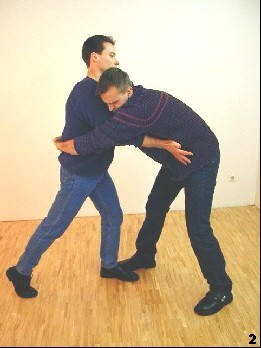 |
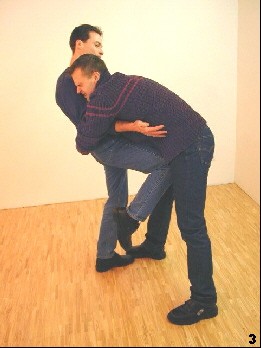 |
|
Fig. 2: Sifu neutralizes the attacker's strength with one or two steps back and finally manages to stop him, stabilizing himself with a support step. This movement is accompanied by a swing back.
|
Fig. 3: Next, a knee attack to the genitals of the attacker is delivered.
|
| Tip |
|
|
|
|
|
In a clinch attempt, normally the open arms position offers space for direct techniques such as chain punches, thumb attacks to the eye, upward elbows, etc. If the attacker is able to corner you and press you against a wall, try to apply a head butt to his nose or even bite him. This will force him to release the grip.
|
Exercise 53: Defense Against Clinch from the Front (with Lifting)
CLASSICAL WING TSUN EXTENDED
Wing Tsun Lesson 10: Defense Against Clinches
Exercise 53: Defense Against Clinch from the Front with Lifting → Leg Swings Back and Knee Attack
Initial Position
 |
 |
| |
|
Also try to hold the opponent with one or both hands. If he can throw you down, drag him with you.
|
|
Exercise 54: Defense Against Rear Naked Choke, Variant 1
CLASSICAL WING TSUN EXTENDED
Wing Tsun Lesson 11: Defense Against Choking
Exercise 54: Defense Against a Rear Naked Choke → Backward Elbow and Claw Hand to the Eyes
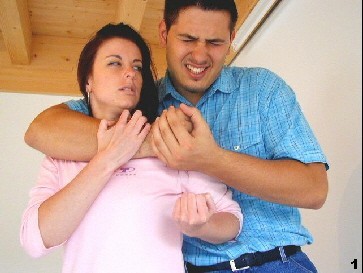 |
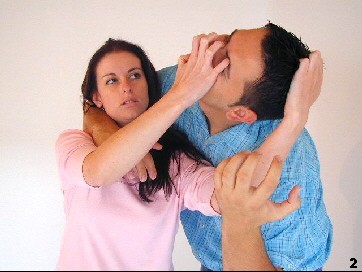 |
|
Fig. 1: Verena is attacked from behind, with the attacker performing a rear naked choke. Immediately she delivers a backward elbow to his stomach. At the same time, she pulls his arm down to relieve the pressure from the choke.
|
Fig. 2: The backward elbow makes the attacker bend forward, which means Verena will be able to reach out and grip the attacker's hair. She pulls his head down and attacks his eyes with a clawed hand.
|
|
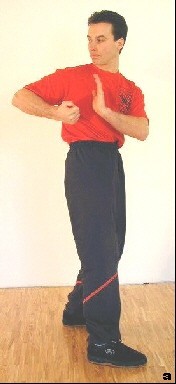
|
Fig. a: Preliminary exercise for the backward elbow: the backward elbow will have more impact and reach if it is delivered with trunk rotation.
|
Exercise 55: Defense Against Rear Naked Choke, Variant 2
CLASSICAL WING TSUN EXTENDED
Wing Tsun Lesson 11: Defense Against Choking
Exercise 55: Defense Against Rear Naked Choke → Use of Circular Step and Knee Lever
Initial Position

Exercise 56: Defense Against Side Headlock, Variant 1
CLASSICAL WING TSUN EXTENDED
Wing Tsun Lesson 11: Defense Against Choking
Exercise 56: Defense Against a Headlock from the Side → Nose Lever and One-Arm Guided Punches
Initial Position
 |
 |
 |
 |
| |
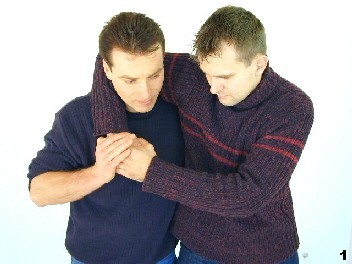 |
| |
| |
Fig. 1: The opponent attacks from the side, trying to apply a side headlock to Sifu's neck.
|
|
|
|
| |
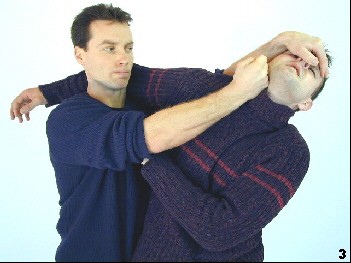 |
|
| |
| |
Tip
|
|
|
 |
 |
 |
 |
| |
 |
| |
| |
Fig. 2: From this position, it is very easy for Sifu to reach, with his left free hand, the head of the opponent from behind. Sifu applies a lever to his nose with the thumb. The other fingers of his left hand rest on the opponent's forehead as a way of stabilizing the movement. The opponent is pulled by the nose simultaneously, back and down.
|
|
|
|
| |
Fig. 3: While Sifu executes the lever to the nose, he uses his right arm to punch the opponent's head, uninterruptedly.
|
|
|
 |
 |
| |
|
Instead of applying a lever to the nose, the same effect is also possible by pulling the hair or "pinching" the eye cavity.
|
|
Exercise 57: Defense Against Side Headlock, Variant 2
CLASSICAL WING TSUN EXTENDED
Wing Tsun Lesson 11: Defense Against Choking
Exercise 57: Defense Against a Headlock from the Side → Attack to the Low Abdomen or Palm Strikes
Initial Position
| Tip |
|
|
|
|
|
Instead of a hammer attack to the opponent's low abdomen, a squeezing grip on the genitals could also be effective, depending on his clothing. Blows with the palms to the back of the opponent's head are very effective because they shake his head, especially if the technique is performed quickly and repeatedly. Blows to the ears cause pain due to pressure on the eardrum. In both cases, the attacker loses the orientation.
|
Exercise 58: Defense Against Side Headlock, Variant 3
CLASSICAL WING TSUN EXTENDED
Wing Tsun Lesson 11: Defense Against Choking
Exercise 58: Defense Against a Headlock from the Side → Lever on the Knee
Initial Position
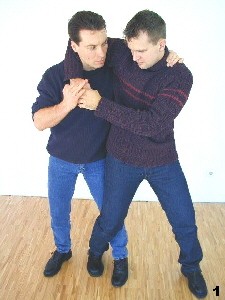 |
 |
 |
|
Fig. 1: The opponent tries to apply a side headlock on Sifu's neck.
|
Fig. 2: Sifu performs, with his knee, a lever behind the opponent's knee. With his left hand he pulls the opponent's shoulder back.
|
Fig. 3: Because of the lever behind his knee, the opponent falls to the ground.
|
 |
 |
|
|
Fig. 4: Sifu pulls the opponent's neck with both hands, in his own direction. Then, he delivers a knee attack.
|
Fig. 4a: Alternatives to the knee attack, could be an elbow strike or an uppercut. To do this, Sifu puts his left arm on the opponent's neck, and attacks with his right arm.
|
|
Exercise 59: Defense Against Choking from the Front
CLASSICAL WING TSUN EXTENDED
Wing Tsun Lesson 11: Defense Against Choking
Exercise 59: Defense Against Choking from the Front → Body Rotation with Pull on the Arm and Thumb Attack
Initial Position
 |
 |
| |
|
This solution is also a good option if the opponent has arms that are much longer than your. Because of the trunk rotation, the reach of your arm increases significantly.
|
|
Exercise 60: Defense Against Choking from Behind
CLASSICAL WING TSUN EXTENDED
Wing Tsun Lesson 11: Defense Against Choking
Exercise 60: Defense Against Choking from Behind → Man-Sao in Circle - Neck Grab - Elbow Attack
Initial Position
|
|
 |
 |
| |
Fig. 4: Sifu changes the Man-Sao arm into a neck-pull, controlling the arm of the opponent at the elbow.
|
|
 |
 |
| |
Fig. 5+6: The opponent's controlled elbow serves as a pivot for the next Kap-Jarn elbow strike, i.e., the elbow reaches its target while the hand controls the arm underneath.
|
|
|
 |
 |
| |
Tip
|
 |
 |
| |
|
The solution described here can also be used against a back collar grip.
|
|
Exercise 61: Defense Against Takedowns - Basic Exercise "Falling Knee"
CLASSICAL WING TSUN EXTENDED
Wing Tsun Lesson 12: Defense Against Takedowns
Exercise 61: Basic Exercise - "Falling Knee"
 |
 |
| |
Tip
|
 |
 |
| |
|
While practicing with a partner, apply your body weight in a very dosed and controlled manner. Never simply fall with all your body weight on your partner! The destructive effect of a falling knee is usually underestimated and can easily break a person's ribs.
|
|

Exercise 62: Defense Against Takedowns - Pressing the Head Down Using Gam-Sao + Falling Knee
CLASSICAL WING TSUN EXTENDED
Wing Tsun Lesson 12: Defense Against Takedowns
Exercise 62: Defense Against Takedowns → Retreat, Pull the Opponents Head Down and Control with Falling Knee
Initial Position
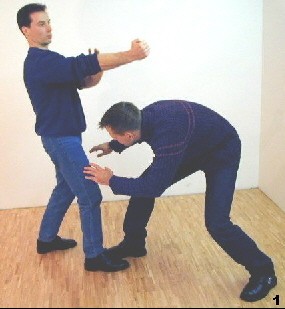 |
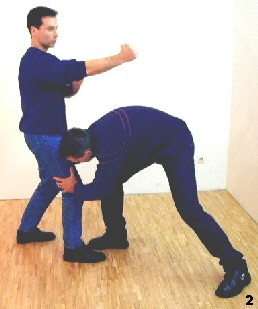 |
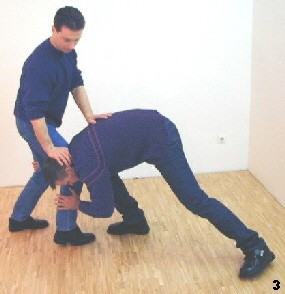 |
|
Fig. 1: After Sifu Dragos has advanced with his leg in front and a punch, the opponent lowers himself, trying to grab both of his legs
|
Fig. 2: The opponent manages to reach Sifu's legs. His goal is to perform a single or a double leg takedown.
|
Fig. 3: Then, Sifu changes from an offensive strategy to a defensive one: he pushes the head and the trunk of the opponent down with Gam-Sao, taking a step back.
|
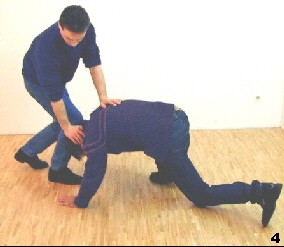 |
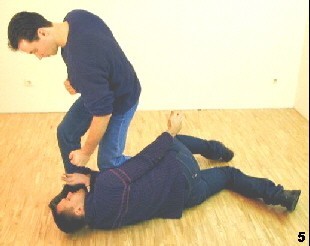 |
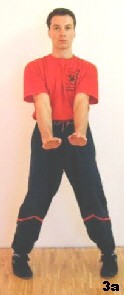 |
|
Fig. 4: Because of the pressure down on his head, the opponent falls to the ground.
|
Fig. 5: Sifu performs a falling knee with a simultaneous punch to the opponent's head.
|
Fig. 3a: Gam-Sao ("Pressing Hand") is a movement of the Siu Nim Tao Form - where basic techniques are taught. For more on this, see DWT 3.0 : Form Training - Siu Nim Tao-, Chum Kiu-, Biu Tze and Wooden Dummy.
|
 |
 |
| |
Info
|
 |
 |
| |
|
The Gam-Sao technique must be delivered with a "pulling" force here, and must, in no case, be directed against the impetuous force of the opponent. In this way, we add our power to the his force, instead of opposing to it.
|
|
Exercise 63: Defense Against Takedowns - Pressing the Head with Gam-Sao + Turning the Head
CLASSICAL WING TSUN EXTENDED
Wing Tsun Lesson 12: Defense Against Takedowns
Exercise 63: Defense Against Takedowns → Retreating - Pressing the Head Down - Turning the Head - Control with Falling Knee
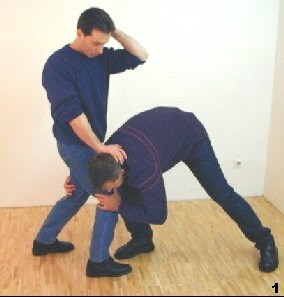 |
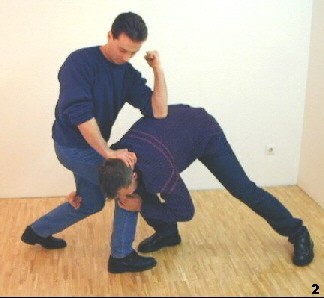 |
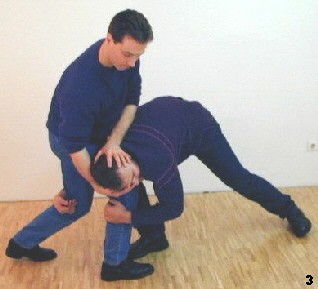 |
|
Fig. 1: The opponent attacks Sifu's legs. His goal is to grab Sifu's legs and lift them off the ground, placing him on his shoulder to then project him to the ground.
|
Fig. 2: Sifu takes a step back, pushing the opponent's head down with Gam-Sao and performs an elbow downward attack, directed at the opponent's spine, empowered with body weight.
|
Fig. 3+4: The opponent was successfully stopped. Sifu grabs the opponent's head and takes another step back. He turns the opponent's head, making him fall to the ground.
|
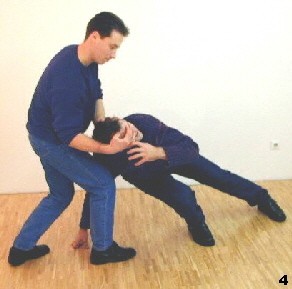 |
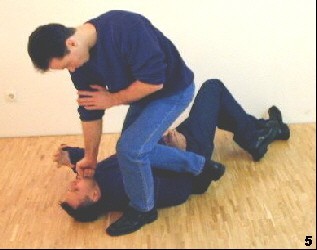 |
Fig. 5: Sifu immediately performs a falling knee to the opponent's chest and also hits him with a punch to the head.
|
| |
|
Do not wait until the opponent is completely on the ground to attack him, instead attack when he is falling. That way, after he has fallen, there is no way he'll regain his orientation. Instead of a falling knee, a kick could also be executed here.
|
|
Exercise 64: Defense Against Takedowns → Crossing Kick
CLASSICAL WING TSUN EXTENDED
Wing Tsun Lesson 12: Defense Against Takedowns
Exercise 64: Defense Against Takedown with Limited Space → Crossing Kick
Initial Position
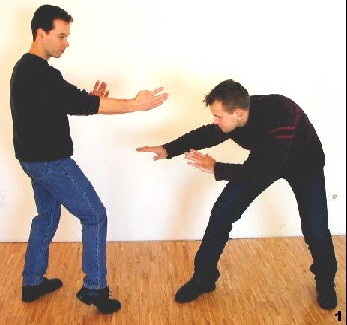 |
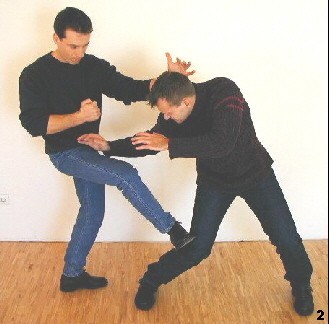 |
|
Fig. 1: The opponent tries to grab Sifu and throw him to the ground.
|
Fig. 2: Immediately, Sifu executes a crossing kick to the opponent's knee.
|
 |
 |
|
Fig. 3: Because of the kick, executed simultaneously with a neck pull, the opponent loses balance and falls to the ground.
|
Fig. 4: While Sifu's kick immobilizes the opponent's leg, his uppercut hits him in the face.
|
The crossing kick is a technique of the WT Wooden Dummy Form. It is suitable for short distances. The back of the knee or the knee joint itself are some of the weakest parts of the body. Here we can very easily break the opponent's balance using the principle of "pull and push on two levels".
|
|
Exercise 65: Defense Against Leg Sweeping - Counterattack with Tan-Gerk Knee Strike
CLASSICAL WING TSUN EXTENDED
Wing Tsun Lesson 13: Defense Against Takedowns and Sweeps
Exercise 65: Defense Against Frontal Sweeping from Outside → Counterattack with Tan Gerk and Knee Strike
Initial Position
 |
 |
 |
 |
| |
 |
| |
| |
Fig. 1: The opponent pulls Sifu Dragos close to him and tries to execute a leg sweep.
|
|
|
|
| |
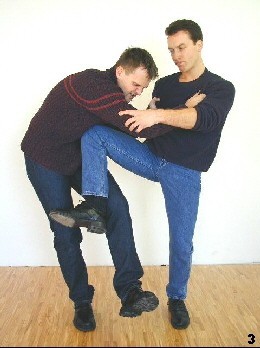 |
|
|
|
|
Tip
|
|
|
 |
|
 |
| |
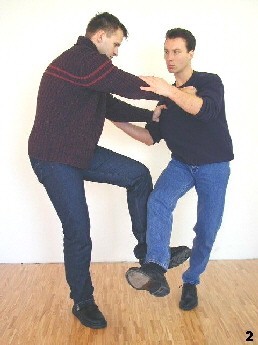 |
|
| |
| |
Fig. 2: Because Sifu's front leg has no weight in it, the sweep has no effect (the attack passes directly).
|
| |
|
|
Fig. 3: The opponent's sweep raises Sifu's right leg and facilitates the execution of a diagonal knee from the outside (Tan-Gerk Knee Strike).
|
|
 |
 |
| |
|
The Tan-Gerk Knee Strike should slide on the thigh of the opponent. At the moment of execution, you should pull the opponent towards you and push the hips forward to achieve a greater range.
|
|
Exercise 66: Defense Against Diagonal Takedown → Counter-Takedown Using 180° Turn
CLASSICAL WING TSUN EXTENDED
Wing Tsun Lesson 13: Defense Against Takedowns and Sweeps
Exercise 66: Defense Against Takedown → Counter Takedown with 180° Turn
Initial Position
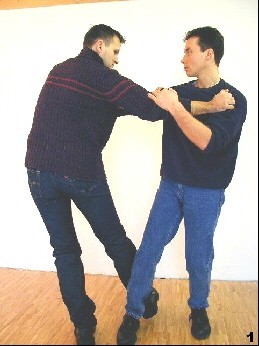 |
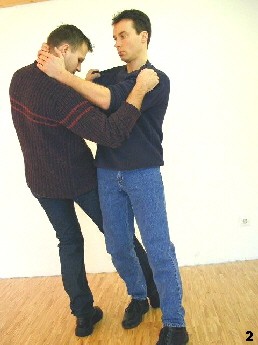 |
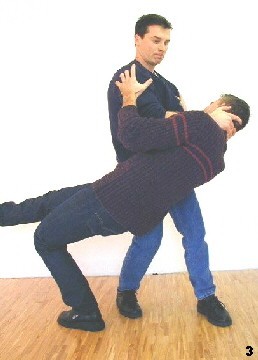 |
|
Fig. 1: The opponent attempts to execute a sweep on Sifu's front leg. He puts pressure on Sifu's shoulders.
|
Fig. 2: Sifu transfers his body weight to the right leg and, using the pressure on his shoulder, executes a 180º turn. He makes his turn exactly at the moment when the sweeping technique of his opponent touches his leg.
|
Fig. 3: Sifu's sudden turn causes the opponent to lose balance. In order not to lose contact with the opponent, to perform the following actions, Sifu grabs him by the neck with both hands.
|
|
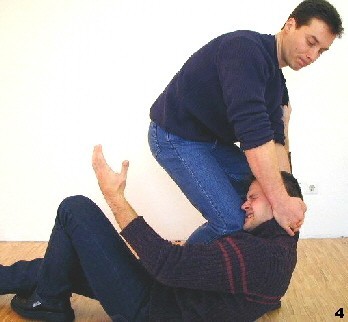
|
|
|
|
Fig. 4: At the moment the opponent falls to the ground, Sifu attacks with the knee.
|
|
|
| This solution is appropriate, even if there is weight on your front leg during the attack. The important thing here is the exact timing of the turning, at the moment of contact with the leg of the opponent. Since the opponent also exerts pressure on our shoulder area, our turning is facilitated by his attack. |
|
Übung 66 - gegen diagonales Fegen von aussen: Gegenwurf durch Wendung
Exercise 67: Defense Against Diagonal Takedown → Passing Leg + Side Kick
CLASSICAL WING TSUN EXTENDED
Wing Tsun Lesson 13: Defense Against Takedowns and Sweeps
Exercise 67: Defense Against Takedown → Passing Leg with Side Kick
Initial Position
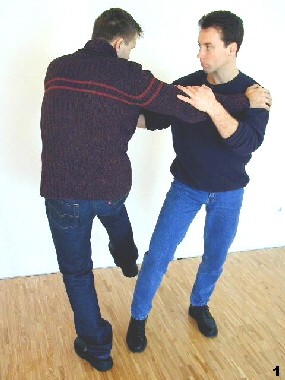 |
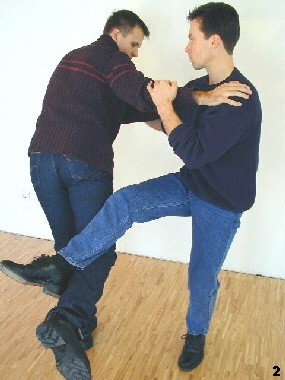 |
|
Fig. 1: The opponent tries to execute a sweep from the outside.
|
Fig. 2: Sifu Dragos lets the opponent's leg pass.
|
 |
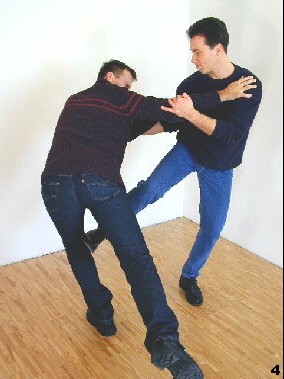 |
|
Fig. 3+4: After the opponent's attack has passed Sifu's weightless leg, Sifu can now swing his leg back and hit the opponent's supporting leg with a side kick.
|
Übung 67 - gegen diagonales Fegen von aussen: Hyen-Gerk + Tritt zum Standbein
Exercise 68: Defense Against Diagonal Sweep From Inside → Bong-Gerk Knee Strike
CLASSICAL WING TSUN EXTENDED
Wing Tsun Lesson 13: Defense Against Takedowns and Sweeps
Exercise 68: Defense Against Diagonal Sweep From Inside → Bong-Gerk Knee Strike
Initial Position
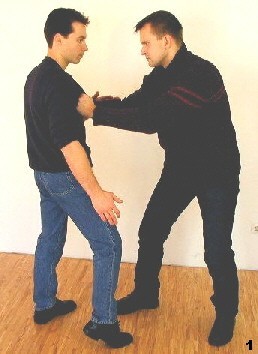 |
 |
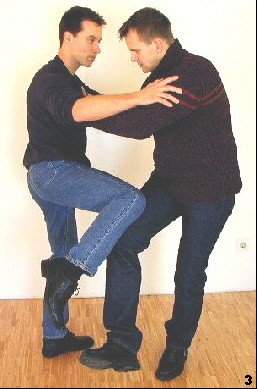 |
|
Fig. 1: Der Angreifer setzt zu einer Fegetechnik an der Innenseite von Sifus vorderem Bein an.
|
Fig. 2: Statt gegen die Bewegung Widerstand zu leisten, lässt Sifu den Angreifer gewähren.
|
Fig. 3: Der Fegeangriff des Gegners “trägt” Sifus Bein, die Wirkung geht jedoch ins Leere.
|
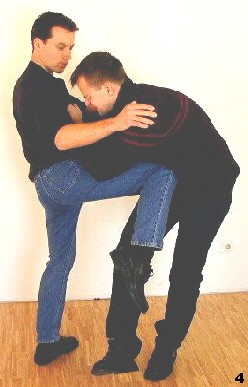 |
|
|
|
Fig. 4: Durch die Aktion des Gegners angehoben, gleitet Sifus Bein entlang des Oberschenkels nach oben. Sifu trifft den Angreifer mit einem Kniestoß
|
|
|
| |
|
|
|
| |
Tip
|
|
| |
| |
|
Falls Sie Ihr Gleichgewicht bei dieser Aktion durch das Ziehen des Gegners verlieren sollten, halten Sie sich an ihm fest und führen Sie die Technik dennoch aus. Das Gleiten auf dem Oberschenkel stellt einen Schutz und Kontrolle vor einemmöglichen Kniestoß von Seiten des Gegners dar.
|
|
| |
Exercise 69: Defense Against Shoulder Throw → Crossing Step + Ankle Lever
CLASSICAL WING TSUN EXTENDED
Wing Tsun Lesson 13: Defense Against Takedowns and Sweeps
Exercise 69: Defense Against Shoulder Throw → Crossing Step, Ankle Lever and Elbow Strike
Initial Position
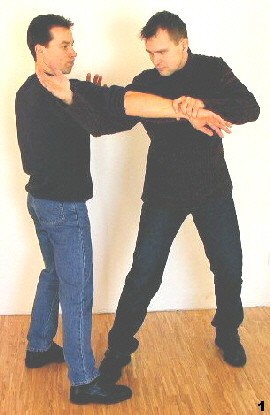 |
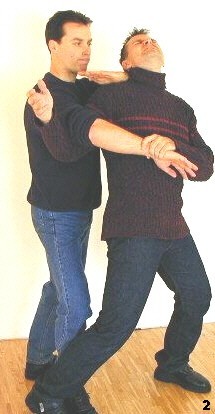 |
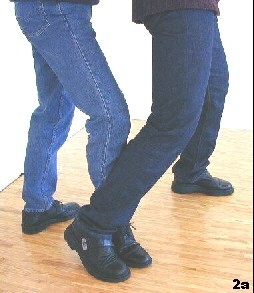 |
|
Fig. 1: Der Angreifer zieht Sifu Dragos am Arm und setzt zu einem Schulterwurf an
|
Fig. 2+2a: Sifu führt einen Kreuzschritt aus, indem er seinen rechten Fuß an der Innenseite des gegnerischen rechten Beines aufsetzt. Daraufhin hebt er seine Ferse an und führt durch Vordrücken seines Knies einen Sprunggelenkhebel aus. Der Sprunggelenkhebel zwingt den Angreifer in die Knie. Gleichzeitig trifft Sifus Pai-Jarn-Sao (horizontaler “Hackender Ellbogen”) den Gegner am Hinterkopf.
|
 |
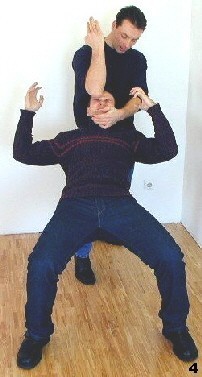 |
|
|
Fig. 3: Sifu macht einen Schritt zurück und zieht den Angreifer dabei an der Stirn nach hinten, wodurch dieser sein Gleichgewicht verliert.
|
Fig. 4: Der Angreifer gleitet auf Sifus Oberschenkel zu Boden. Sifu hält ihn dabei für einen Augenblick am Kinn zurück und führt einen Abwärtsellbogen zu dessen Gesicht aus.
|
|
| |
|
|
|
| |
Tip
|
|
| |
| |
|
Bei sehr großen Gegnern ist es anstelle des Kreuzschrittes auch möglich, mit einem großen Vorwärtsschritt von hinten in den Schritt des Gegners zu gehen, um damit eine für uns günstige Statik und Stabilität zu erzeugen und einen Wurf zu vereiteln. Dadurch, dass uns der Gegner den Rücken zeigt, trifft unser Ellbogen problemlos den Hinterkopf. Können wir diesen dennoch nicht erreichen, bietet sich alternativ ein Ellbogen-Schlag zu den freien Rippen, wodurch sich der Gegner meist aufrichtet und im Weiteren wiederum am Kopf gegriffen werden kann.
|
|
| |

Exercise 70: Defense Against Body Attack → Long Distance Side Kick
CLASSICAL WING TSUN EXTENDED
Wing Tsun Lesson 14: Defense Against Body Attacks (Bodycheck)
Exercise 70: Defense Against Body Attack (Bodycheck) → Takedown with Side Kick
Initial Position
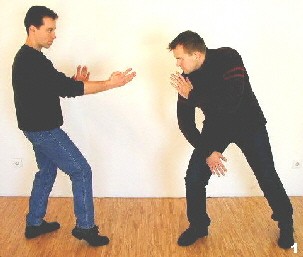 |
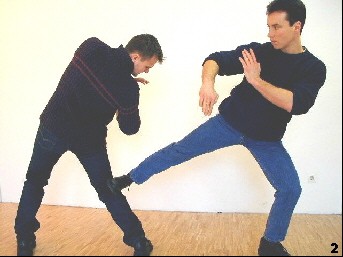 |
|
Fig. 1: The opponent prepares to execute a shoulder attack.
|
Fig. 2: Sifu performs a long range side kick to the opponent's knee. Because of the impact, the opponent falls to the ground.
|
| |
|
|
|
| |
Tip
|
|
| |
| |
|
The success of this solution depends on the posture and the speed with which the opponent advances. The forward projection of our hip extends the reach of the side kick, so that we are able to reach the opponent early on. For a situation in which your reaction is delayed and you are forced to kick the opponent at a closer range, see the option illustrated in Exercise 71: Defense Against Body Attack - Close Range Crossing Kick.
|
|
| |
Exercise 71: Defense Against Body Attack → Short Distance Crossing Kick
CLASSICAL WING TSUN EXTENDED
Wing Tsun Lesson 14: Defense Against Body Attacks (Bodycheck)
Exercise 71: Defense Against Body Attack (Bodycheck), Variant 2 → Crossing Kick - Falling Knee and Punch
Initial Position
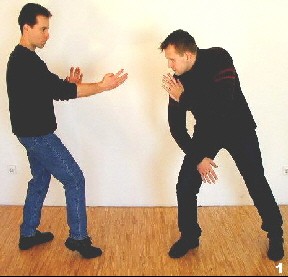 |
 |
|
|
Fig. 1: The opponent approaches to execute a shoulder attack.
|
Fig. 2: Sifu Dragos attacks the opponent with his rear (left) leg.
|
|
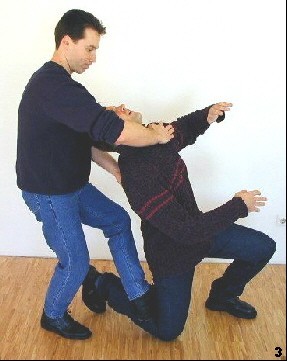 |
 |
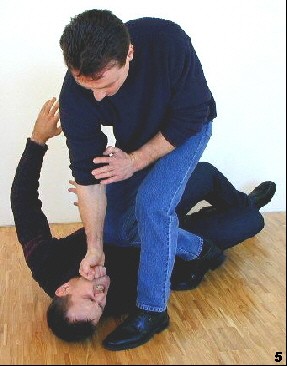 |
|
Fig. 3+4: Sifu's crossing kick and hands pressure rotate the opponent's body, making him fall to the ground.
|
Fig. 5: Finally, Sifu performs a falling knee and a punch at the same time.
|
| |
|
|
|
| |
Tip
|
|
| |
| |
This solution of how to handle with shoulder attacks is particularly suitable for use in small spaces. It is advisable to practice this technique with caution since a kick executed laterally against the knee can easily rupture your partner's ligaments!
|
|
| |
CLASSICAL WING TSUN EXTENDED - Part 3: Defense on the Ground
Exercise 72: Ground Fighting Basic Exercises → Frontal Kick Forward And Upward
CLASSICAL WING TSUN EXTENDED
Wing Tsun Lesson 15: Ground Fighting Basic Exercises
Exercise 72: Frontal Kick Forward And Upward
Initial Position
| |
|
|
|
|
|
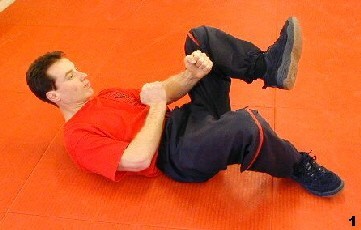
|
|
| |
|
|
|
|
|
Fig. 1: Sifu is lying at the ground in the anti-ground fight position. He raises his kicking leg. The other leg keeps contact with the ground to change direction. The head is raised to allow the best possible view. His arms assume a central position.
|
|
| |
|
|
|
|
|

|
|
 |
 |
|
Fig. 2a / 2b: From the basic position, Sifu Dragos now performs kicks up and forward. The foot lays on the ground stabilizes all movements and also serves as protection for the abdomen.
|
 |
 |
 |
 |
| |
Tip
|
|
| |
| |
|
Practice these and the steps described below together with a partner against resistance (e.g., padding) to get a feel for this particular position. Practicing on percussion pads in standing posture can not replace this.
|
|
| |
| |
|
|
Exercise 73: Ground Fighting Basic Exercises - Bong-Gerk Kick
CLASSICAL WING TSUN EXTENDED
Wing Tsun Lesson 15: Ground Fighting Basic Exercises
Exercise 73: Bong-Gerk Kick
Initial Position
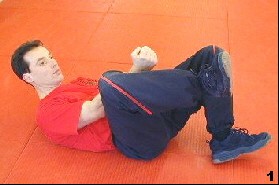 |
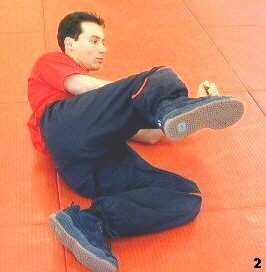 |
|
Fig. 1-3: Out of the anti-ground fighting basic position (Figure 1) Sifu Dragos swings his knee to Bong-Gerk (Figure 2) and stretches his leg to kick (Figure 3). The position gets it´s stability by the other leg lying on the ground.
|
QD3 / Lektion 15 - Basistechniken für den Bodenkampf
Exercise 74: Ground Fighting Basic Exercises → Tan-Gerk Kick
CLASSICAL WING TSUN EXTENDED
Wing Tsun Lesson 15: Ground Fighting Basic Exercises
Exercise 74: Tan-Gerk Kick
Initial Position
Exercise 75: Ground Fighting Basic Exercises → Gan-Gerk
CLASSICAL WING TSUN EXTENDED
Wing Tsun Lesson 15: Ground Fighting Basic Exercises
Exercise 75: Gan-Gerk ("Cutting Leg")
Initial Position
 |
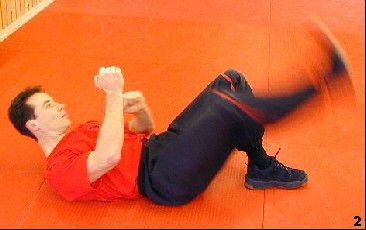 |
|
Fig. 1+2: To execute the Gan-Gerk ("Cutting Leg"), Sifu Dragos swings his leg up and moves it downwards towards the ground. The technique can be applied for defense as well as to attack.
|
Exercise 76: Ground Fighting Basic Exercises → Lateral Protection by Tan-Gerk And Arm Shield
CLASSICAL WING TSUN EXTENDED
Wing Tsun Lesson 15: Ground Fighting Basic Exercises
Exercise 76: Lateral Protection by Tan-Gerk and Arm Shield
Tan-Gerk and Arm Shield
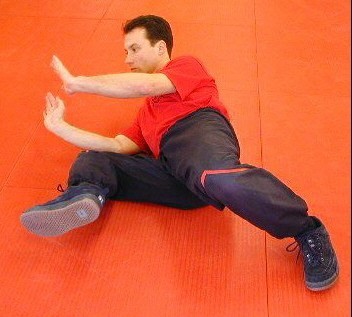 |
|
Figure:
To protect his body Sifu Dragos covers his upper trunk by holding both hands in front of him. At he sam time his right leg forms a Tan-Gerk as a shield. This posture is needed when the opponent succeeds in walking past our legs and applies kicks to our trunk or head. In order not to miss the moment of necessary body tension, the arms are tensed isometrically.
|
Exercise 77: Ground Fighting Basic Exercises → Lateral Protection With Bong-Gerk
CLASSICAL WING TSUN EXTENDED
Wing Tsun Lesson 15: Ground Fighting Basic Exercises
Exercise 77: Lateral Protection With Bong-Gerk
Initial Position
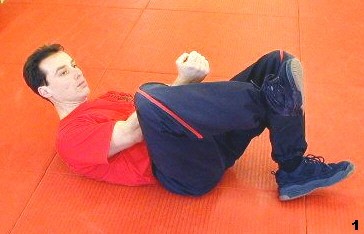 |
|
Fig. 1+2: This technique is the counterpart to Tan-Gerk protection: Sifu rolls to the side, carries out a Bong-Gerk while holding two arms in front of his head and trunk area. The abdomen and abdomen are protected by the leg technique.
|
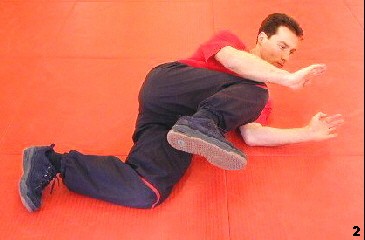 |
Exercise 78: Ground Fighting Basic Exercises - Circular Foot Movement Huen-Gerk
CLASSICAL WING TSUN EXTENDED
Wing Tsun Lesson 15: Ground Fighting Basic Exercises
Exercise 78: Circular Foot Movement Huen-Gerk
Initial Position
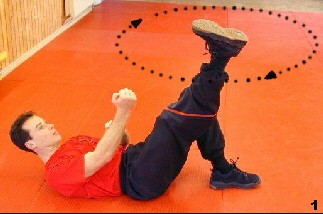 |
| Fig. 1 - Scheme of the Circular Foot Movement: The following circular foot movement can be performed with or counter-clockwise. |
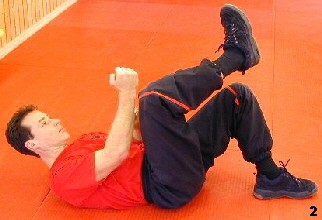 |
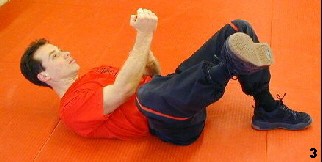 |
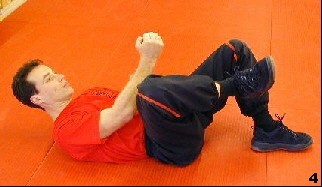 |
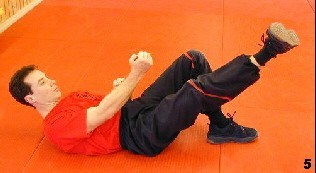 |
| Fig. 2-5: Sifu slightly angled his footstep and made a circular movement with his foot. Then he kicks to the front. |
Exercise 79: Ground Fighting Basic Exercises → Chain Kicks
CLASSICAL WING TSUN EXTENDED
Wing Tsun Lesson 15: Ground Fighting Basic Exercises
Exercise 79: Chain Kicks
Intitial Position
|
|
 |

|
| |
Fig. 1-7: Starting from the lying postion, Sifu performs alternating kicks with the right or left leg. The process looks similar to "cycling".
|
|
| Info |
|
|
|
|
|
|
Chain kicks are regarded as being a "long-range weapon" in anti-ground and ground fight. They are used to keep an approaching opponent back from us or to continue our attack. Comparable to a compass needle try to constantly turn towards the opponent and kick the first target that comes into reach. As soon as the situation allows, we try to get back up and stand up as quickly as possible.
|
Exercise 80: Ground Fighting Basic Exercises → Scissors Stretch
CLASSICAL WING TSUN EXTENDED
Wing Tsun Lesson 15: Ground Fighting Basic Exercises
Exercise 80: Scissors Stretch
Intitial Position
 |
 |
|
Fig. 1+2: Sifu Dragos crosses his ankles and angles the feet. In order to reduce the load on the knee joint tapes during the following execution, he places both knees slightly outwards. Now he stretches both legs with strength.
|
| Tip |
|
|
|
|
|
The stretching scissor is often used to immobilize an opponent, which is between our legs. But also the pressure on sensitive body parts (e.g., neck) can achieve a final effect.
|
Exercise 81: Ground Fighting Basic Exercises → Bridge Movement
CLASSICAL WING TSUN EXTENDED
Wing Tsun Lesson 15: Ground Fighting Basic Exercises
Exercise 81: The Bridge Movement
Initial Position
| Tip |
|
|
|
|
|
Depending on its aplication the bridge movement can be executed with or without using our hands. Most of the time it serves to drop an opponent lying or sitting on us, or helps us to lift the opponent for a moment, and then use other techniques.
|
Exercise 82: Ground Fighting Basic Exercises → Triangle Position (Bong-Gerk-Fixation)
CLASSICAL WING TSUN EXTENDED
Wing Tsun Lesson 15: Ground Fighting Basic Exercises
Exercise 82: Triangle Position (Bong-Gerk Fixation)
Initial Position
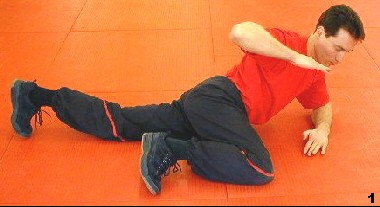 |
|
Fig. 1+2: Lying on his stomach, Sifu Dragos supports himself with his left forearm. His right leg is Bong-Gerk position. From this stable position he now gives an elbow strike.
|
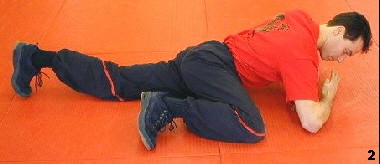 |
Übung 82: Dreiecks-Stand “Bong-Gerk-Fixierung”
| Tip |
|
|
|
|
|
|
The Bong-Gerk fixation is one of the most commonly used immobilization techniques for ground fighting. According to the principle that each object stands firmly on three legs, and the size of the base determines the degree of stability, we try to keep this surface as large as possible, ie. to spread out the limbs accordingly and keep our trunk flat on the ground.
|
Exercise 83: Ground Fighting Basic Exercises → Supporting Stand
CLASSICAL WING TSUN EXTENDED
Wing Tsun Lesson 15: Ground Fighting Basic Exercises
Exercise 83: Supporting Stand
Initial Position
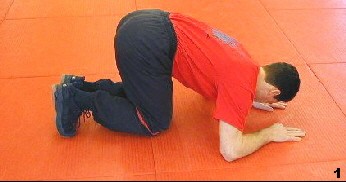 |
|
Fig. 1: Sifu Dragos pulls his legs and takes a "kneeling" position. It is supported by his forearms and the tips of the forefoot. The knees "hover" just above the ground, so do not touch it.
|
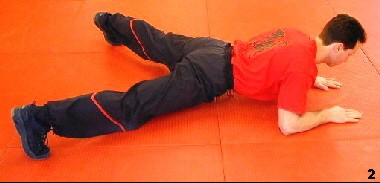 |
|
Fig. 2: Now Sifu stretches his legs. His entire body is "hovering" above the ground. Only his forefeet and forearms are touching the ground.
|
| Tip |
|
|
|
|
|
|
This position enables us to have stability during controlling maneuvers. In the above example, it is executed alternately with a double knee strike. The postion of allows single leg knee strikes as well.
|
Exercise 84: Ground Fighting Basic Exercises → Knee Bump and Back Kick
CLASSICAL WING TSUN EXTENDED
Wing Tsun Lesson 15: Ground Fighting Basic Exercises
Exercise 84: Knee Bump and Back Kick
Initial Position
 |
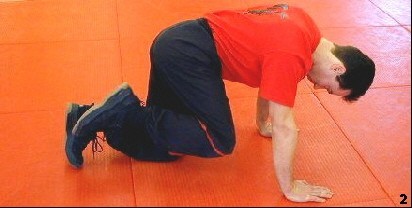 |
|
Fig. 1: From the four-point kneeling stance, Sifu Dragos executes a kick backwards.
|
Fig. 2: Then he moves downward to apply a knee attack with the same leg.
|
Übung84: Rückwärtstritt und Kniestoss im Vierfüsslerstand
Exercise 85: Ground Fighting Basic Exercises - Standing Up From the Ground While Moving Backward
CLASSICAL WING TSUN EXTENDED
Wing Tsun Lesson 15: Ground Fighting Basic Exercises
Exercise 85: Standing Up From The Ground While Moving Backward
Initial Position
 |
 |
| |
Fig. 3+4: While his hands and left leg pushes form the ground he does a step back with his right leg. As he moves away form his opponent he does not need to protect his upper regions much.
|
|
|
| |
|
|
|
Tip
|
|
| |
| |
|
Being able to get back up quickly from a lying position can decide victory and defeat.. In Wing Tsun we never voluntarily move to the ground. If we have to stand up from the ground we will always try to do that by moving backward. This provides us extra time and distance to the enemy. Alternatively to the shown example we could have stood up by moving back in a lateral manner, using 1 arm to push from the ground while the other protects us and by using a crossing step to move away from the opponent.
|
|
|
Exercise 86: Defending Against Attackers From a Lying Position → Stop Kick Against Kicks or Approaching Opponent
CLASSICAL WING TSUN EXTENDED
Wing Tsun Lesson 16: Defending Against Attackers From a Lying Position
Exercise 86: Stop Kick Against Kicks or an Approaching Opponent
Initial Position
|
|
 |
 |
| |
Fig. 1: Melanie applies the anti-ground fight basic postion while bending her right leg. Her left leg keeps contact to the ground for the purpose of aligning her position to the opponent.
|
|
 |
 |
| |
|
When beeing appoached by an opponent we always try to kick the frist possible target we can reach. This can be a leg of the opponent, hands, trunk or head, depending on what is within reach of our kick. Afterwards it is necessary to stand up immediately. Stop kicks are useful when the opponent is approaching us quickly. During a slow approach however there is also the possibility to apply a lock to the shin (shown in Exercise 87: Defending Attackers From A Lying Postion → Shin Lock (in case of slow approaches)).
|
|
Exercise 87: Defending Against Attackers From a Lying Position → Shin Lock (Opponent Approaching Slowly)
CLASSICAL WING TSUN EXTENDED
Wing Tsun Lesson 16: Defending Against Attackers From a Lying Position
Exercise 87: Shin Lock (Opponent Approaching Slowly)
Initial Position
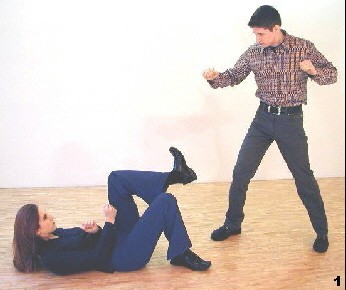 |
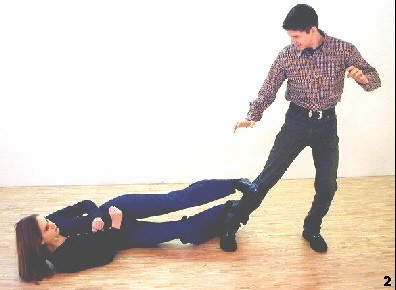 |
|
Fig. 1+2: The attacker underestimates Melanie and is therefore "careless". He comes closer by moving slowly. Melanie applies a shin lock which makes her opponent lose his balance.
|
| Tip |
|
|
|
|
|
|
In the shown example the shin lock could have been applied to the opponents other leg as well without changing body position.
|

Exercise 88: Defending Against Attackers From a Lying Position - How To Protect From Side Positions Using Tan and Bong-Gerk
CLASSICAL WING TSUN EXTENDED
Wing Tsun Lesson 16: Defending Against Attackers From a Lying Position
Exercise 88: How To Protect From Side Positions Using Tan- And Bong-Gerk
Initial Position
| Tip |
|
|
|
|
|
|
It is important that we stand up quickly after we manage to lock the opponents leg and make him fall to the ground. Hold your protecting hands tensed up by isometrics when placing them in front of your upper trunk.
|
Exercise 89: Defending Against Attackers From a Lying Position - How to Deal with Foot Gripping → Use of Huen-Gerk
CLASSICAL WING TSUN EXTENDED
Wing Tsun Lesson 16: Defending Against Attackers From a Lying Position
Exercise 89: How to Deal With Foot Gripping → Use of Huen-Gerk
Initial Position
| Tip |
|
|
|
|
|
| Execute the circling movement of Huen-Gerk naturally always away from the opponents movement and come back fluently to apply the kick when the attacker is close enough. |
Exercise 90: Defending Against Attackers From a Lying Position - How to Deal With Foot Gripping → Using Gan-Gerk to Cut Off the Grip
CLASSICAL WING TSUN EXTENDED
Wing Tsun Lesson 16: Defending Against Attackers From a Lying Position - How to Deal with Foot Gripping
Exercise 90: How to Deal with Foot Gripping → Using Gan-Gerk To Cut Off the Grip
Initial Position
| Tip |
|
|
|
|
|
| Depending on the distance to the opponent, the heel strike by Gan-Gerk could also have been executed to the opponent's head. Alternatively a kick to the shinbone of the opponent could have been applied. |
Exercise 91: Opponent Approaches Us From Above Being Between Our Legs → Bong-Gerk Barrier + Chain Kicks
CLASSICAL WING TSUN EXTENDED
Wing Tsun Lesson 17: Opponent Approaches Us From Above Being Between Our Legs
Exercise 91: Opponent Approaches Us From Above Being Between Our Legs → Bong-Gerk Barrier + Chain Kicks
Initial Position
 |
 |
| |
Fig. 3+4: Melanie pushes the attacker away by pressing down her right knee. 'Then she holds back the opponent with one leg while the other applies a kick to the head.
|
Exercise 92: Opponent Approaches Us From Above Being Between Our Legs → Gan-Gerk to the Opponent's Head
CLASSICAL WING TSUN EXTENDED
Wing Tsun Lesson 17: Opponent Approaches Us From Above Being Between Our Legs
Exercise 92: Opponent Approaches Us From Above Being Between Our Legs → Gan-Gerk to the Opponent's Head
Initial Position
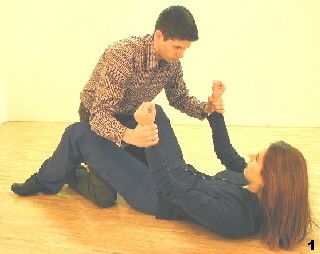 |
|
Fig. 1: The attacker tries to get between Melanie's legs. She presses herself away from her opponent by stretching her legs and "pulling away" with her shoulders. By this she is able to increase the distance to the opponent.
|
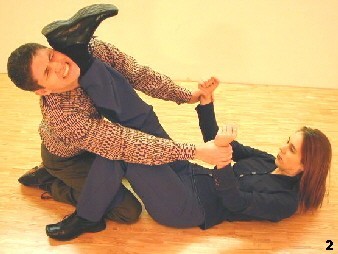 |
|
Fig. 2: This allows her to bring her leg up in order to perform a Gan-Gerk downward chop to the opponent`s head.
|
Exercise 93: Opponent Approaches Us From Above Being Between Our Legs → Bong-Gerk Barrier + Thumb Attack
CLASSICAL WING TSUN EXTENDED
Wing Tsun Lesson 17: Opponent Approaches Us From Above Being Between Our Legs
Exercise 93: Opponent Approaches Us From Above Being Between Our Legs → Bong-Gerk Barrier + Thumb Attack
Initial Position
|
|
| |
|
|
| |
Tip
|
|
| |
| |
|
In order to soften the used weapon you might use the spade hand technique "Chang-Sao". Hereby both edges of your hands will apply handcuts by meeting the attacker's jaw.
|
|
|
Exercise 94: Opponent Approaches Us From Above Being Between Our Legs → Locking the Opponent's Neck with Our Knee
CLASSICAL WING TSUN EXTENDED
Wing Tsun Lesson 17: Opponent Approaches Us From Above Being Between Our Legs
Exercise 94: Opponent Approaches Us From Above Being Between Our Legs → Locking the Opponent's Neck with Our Knee
Initial Position
|
|
| |
 |
 |
 |
 |
| |
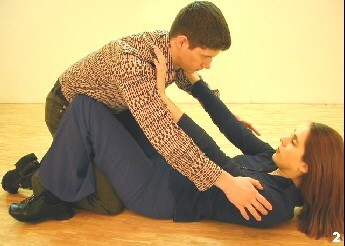 |
| |
| |
Fig. 2: Melanie brings both of her hands to the inside position and pushes the opponent away to hold him back.
|
|
| |
Fig. 3: In the next step she applies a Bong-Gerk barrier and then reaches out for the opponents head. While turning and pulling the attackers head she applies an lock with her knee. Her tights are moving up to enforce the strength of her action.
|
|
|
 |
 |
| |
|
Since the muscles of the neck (trapezius muscle) and the back extensors are quite strong muscles, it is advisable to turn the head of the attacker slightly to the side during the neck pull. This will weaken opponents position an increase the effect of our actions.
|
|

Exercise 95: Opponent Approaches Us From Above Being Between Our Legs → Controlling the Oppenent's Arms + Kick
CLASSICAL WING TSUN EXTENDED
Wing Tsun Lesson 17: Opponent Approaches Us From Above Being Between Our Legs
Exercise 95: Opponent Approaches Us From Above Being Between Our Legs → Controlling The Oppenent's Arms + Kick
Initial Position
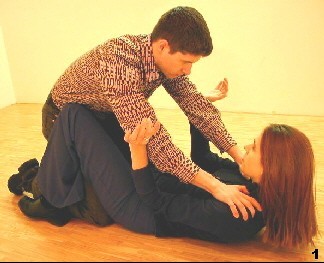 |
 |
|
Fig. 1: Der Angreifer befindet sich zwischen Melanies Beinen und drückt sie an den Schultern zu Boden.
|
Fig. 2: Melanie bringt ihre Arme in den Innenbreich der gegnerischen Arme, drückt dessen Schultern mit beiden Händen zurück und bringt ein Knie zwischen sich und dem Angreifer, um diesen auf Abstand zu halten.
|
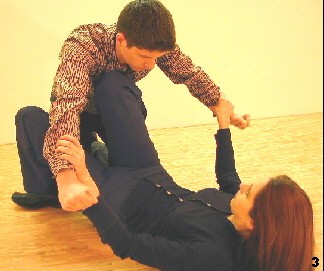 |
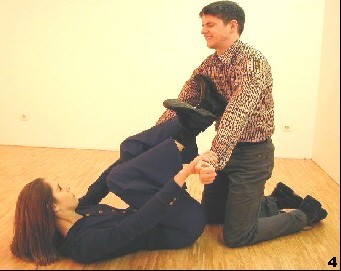 |
|
Fig. 3: Während sie den Angreifer durch ihr abwärts drückendes Knie zurückdrängt, greift sie dessen Handgelenke.
|
Fig. 4: Nun übernimmt sie den Angreifer mit ihrem linken Bein und “spannt” ihn durch Strecken des gleichen Beines auf.
|
 |
Fig. 5: Der “aufgespannte” Angreifer hat nun keine Möglichkeit für eine Gegenwehr und wird durch Melanies Tritt am Kopf getroffen.
|
Exercise 96: Opponent Approaches Us From Above Being Between Our Legs → Scissors Stretch to the Opponent's Neck
CLASSICAL WING TSUN EXTENDED
Wing Tsun Lesson 17: Opponent Approaches Us From Above Being Between Our Legs
Exercise 96: Opponent Approaches Us From Above Being Between Our Legs → Scissors Stretch to the Opponent's Neck
Execution
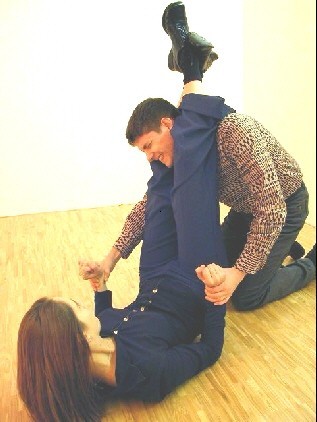 |
g 96
| Tip |
|
|
|
|
|
|
The scissors stretch produces large compressive forces to the opponent's neck. This will lead to interruption of the blood circulation at the throat arteries and in consequence to the opponent's unconsciousness. Practice this exercise with care to avoid brain damage!
|
|
|
Fig. In the course of the fight, Melanie's legs cross the head of the attacker. She takes advantage of this opportunity and puts a scissors stretch to the neck of the attacker.
|
g 96
Exercise 97: Opponent Approaches Us From Above Being Between Our Legs → Applying a Throw with the Use of Bong-Gerk and Gan-Gerk
CLASSICAL WING TSUN EXTENDED
Wing Tsun Lesson 17: Opponent Approaches Us From Above Being Between Our Legs
Exercise 97: Opponent Approaches Us From Above Being Between Our Legs → Applying a Throw with the Use of Bong-Gerk and Gan-Gerk
Initial Position
| Tip |
|
|
|
|
|
| The principle of throwing is always the same: find ways to take away the attacker's possibility to stay stable and bring him out of balance. |
Exercise 98: Opponent Approaches Us From Above Being Between Our Legs → Applying a Throw with the Use of Tan-Gerk
CLASSICAL WING TSUN EXTENDED
Wing Tsun Lesson 17: Opponent Approaches Us From Above Being Between Our Legs
Exercise 98: Opponent Approaches Us From Above Being Between Our Legs → Applying a Throw with the Use of Tan-Gerk
Initial Position
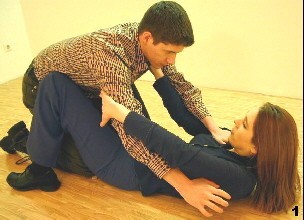 |
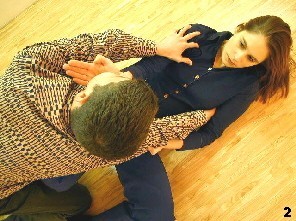 |
|
Fig. 1: The attacker tries to get between Melanie's legs. She immobilizes his right arm to avoid him using it for keeping balance.
|
Fig. 2: Melanie also controls the right knee of the attacker with Gan-Gerk and turns his chin.
|
 |
 |
|
Fig. 3: Melanie additionally lifts her right leg and turns to the left side (Tan-Gerk). The attacker loses his balance.
|
Fig. 4: Melanie immediately rolls on top of the attacker, controls his arms, and applies a double thumb attack.
|
| Tip |
|
|
|
|
|
|
The approach shown here is similar to that of the previous exercise (Exercise 97: Opposing us between the legs → Dumping the Opponent Using of Bong-Gerk / Gan-Gerk), with the difference that this throw here is carried out by Tan-Gerk. The double knee control (Fig. 4) should usually be carried out by heavy persons, especially since this posture is relatively unstable. However, stability can be increased by clinging to the trunk of the opponent (adductor muscles) and applying a strike to the head of the opponent at the same time. A variation to this is the inside hooking to the opponents leg in case he bends one of them.
|
Exercise 99: Opponent Sits On Us → Bridge Throw, Bong-Gerk Fixation And Counterattack
CLASSICAL WING TSUN EXTENDED
Wing Tsun Lesson 18: Opponent Sits On Us
Exercise 99: Opponent Sits On Us → Bridge Throw, Bong-Gerk Fixation and Counterattack
Initial Position
| Tip |
|
|
|
|
|
In order to make your bridge throw technique even more effective you should bend your legs strongly before lifting up your hip. If the opponent's neck can not be grasped, reach out for his cothing.
|
Exercise 100: Opponent Controls or Approaches From the Side → Tan-Gerk Barrier, Knee Strike or Chain Punches
CLASSICAL WING TSUN EXTENDED
Wing Tsun Lesson 19: Opponent Controls or Approaches From The Side
Exercise 100: Opponent Controls or Approaches From the Side → Tan-Gerk Barrier, Knee Strike or Chain Punches
Exercise 100a: Tan-Barrier + Knee Strike
Exercise 100 b: Tan-Barrier + Chain Punches
 |
Fig. 4: The opponent falls forward on Melanie without controlling her arms. She uses a "Tan-Gerk" barrier to hold him back and applies chain punches to his face.
|
Exercise 101: Defense Against Neck Lock In Lying Position → Nose Lock and Knee Strike
CLASSICAL WING TSUN EXTENDED
Wing Tsun Lesson 19: Opponent Controls or Approaches Us From the Side
Exercise 101: Against Headlock From the Side → Nose Lock and Knee Strike
Initial Position
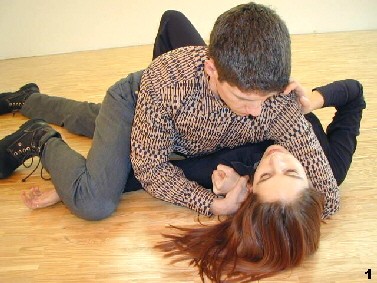 |
 |
|
Fig. 1: The attacker controls Melanie by applying a headlock from the side in lying position.
|
Fig. 2: Melanie applies a lock to the opponent's nose to push him back.
|
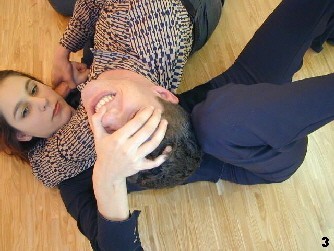 |
| Tip |
|
|
|
|
|
| To apply the lock to an opponent's nose we place four fingers on forehead of the attacker's face and use the thumb to execute the lock. By this you will have better control about your actions. Alternatively you may pull the attacker by his hairs. |
|
Fig. 3: Then, she follows up with a knee strike to his head.
|
Exercise 102: Defense Against Neck Lock In Lying Position → Nose Lock in Combination with Scissors Stretch
CLASSICAL WING TSUN EXTENDED
Wing Tsun Lesson 19: Opponent Controls or Approaches Us From the Side
Exercise 102: Defense Against Neck Lock In Lying Position → Nose Lock in Combination with Scissors Stretch
Initial Position
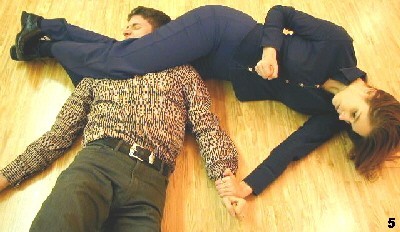 |
Fig. 5: The opponent loses consciousness.
|
Exercise 103: Defense Against Neck Lock In Lying Position → Nose Lock, Gan-Gerk Fixation and Heel Strike
CLASSICAL WING TSUN EXTENDED
Wing Tsun Lesson 19: Opponent Controls or Approaches Us From the Side
Exercise 103: Defense Against Neck Lock In Lying Position → Nose Lock, Gan-Gerk Fixation and Heel Strike
Initial Position
 |
 |
| |
Fig. 1+2: The attacker puts a stranglehold on Melanie's neck. Melanie, with her free hand, applies a nose lock to push the opponent away..
|
 |
 |
| |
Fig. 2+3: ..now she catches the oppoent`s neck with her right leg and control his arm by pulling. She swings up with her left leg to initiate a heel strike.
|
|
|
 |
|
| |
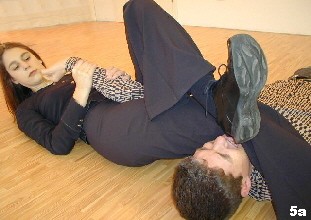 |
| |
| |
Fig. 5a: Alternatively the heel strike could have been executed to the opponent`s face.
|
|
 |
 |
| |
|
You can apply this technique only in case you manage to free your underneath leg. If you cannot do that, simply use the scissors strech to the opponent´s neck as described in Exercise 102.
|
|

Exercise 104: Defense Against Neck Lock In Lying Position → Nose Lock, Triangle Ground Control, Counter Attack by Knee Strike
CLASSICAL WING TSUN EXTENDED
Wing Tsun Lesson 19: Opponent Controls Or Approaches Us From the Side
Exercise 104: Defense Against Neck Lock In Lying Position → Nose Lock, Triangle Ground Control, Counter Attack with Knee Strike
Initial Position
 |
 |
| |
Fig. 1+2: The attacker applies a neck lock in a lying position. Melanie pushes the opponents head back by using a nose lock. Then, she reaches over to catch the attackers head with her leg.
|
 |
 |
| |
|
When using the triangle position always use your bodyweight and regulate your position with the help of your feet. Naturally the opponent will then try to free or unlock the control. We may then be forced to adopt to new situations. Basically the best tactic is to quickly finish the opponent in the moment you have the advantage position.
|
|
Exercise 105: Defense Against Neck Lock In Lying Position → Spinning Throw + Knee Strike
CLASSICAL WING TSUN EXTENDED
Wing Tsun Lesson 19: Opponent Controls or Approaches Us From the Side
Exercise 105: Defense Against Neck Lock In Lying Position → Spinning Throw + Knee Strike
Initial Position
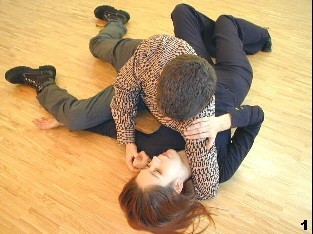 |
 |
|
Fig. 1: The opponent locks Melanies neck in a lying position while he additionally controls her left arm with his knee.
|
Fig. 2: Melanie grabs the opponent's leg and pulls his neck.
|
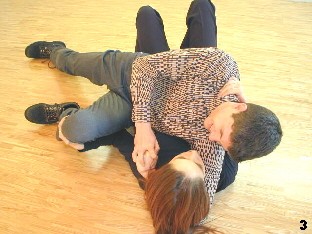 |
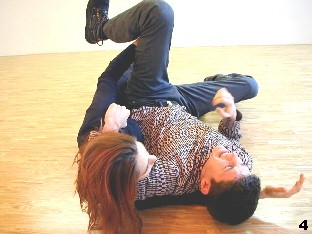
|
|
Fig. 3-4: Before applying a spinning throw she tries to get very close to the opponent's back. By this the opponent's center of gravity gets closer to her's and the throw can be executed very easily.
|
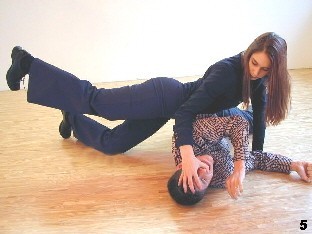 |
 |
|
Fig. 5+6: Melanie applies a strike with her knee to the opponent's head from the triangle control position. To increase the impact, she pulls his head back while doing so.
|
| By throwing the opponent to the other side, we are no longer underneath the attacker, instead we are on top of him. Don't try to lift the opponent up with your arms. Instead, use the leverage advantage when positioning yourself underneath his center of gravity before you apply the throw. |
Exercise 106: Against Immobilization of Arms In Lying Position → Pulling Back and Applying Scissors Stretch to the Neck
CLASSICAL WING TSUN EXTENDED
Wing Tsun Lesson 19: Opponent Controls or Approaches Us From the Side
Exercise 106: Against Immobilization of Arms In Lying Position → Pulling Back and Applying Scissors Stretch to the Neck
Initial Position
If you can't push back from the opponent's shoulders, you should push away from his hips.
|
Exercise 107: Defense Against Fixation with Knee → Pulling Back with Shoulders, Brigde Throw and Scissors Stretch to the Neck
CLASSICAL WING TSUN EXTENDED
Wing Tsun Lesson 19: Opponent Controls or Approaches Us From the Side
Exercise 107: Defense Against Fixation with the Knee → Pulling Back with Shoulders, Brigde Throw and Scissors Stretch to the Neck
Initial Position
The bridge throw technique will be easier to execute if you manage to bring your throwing arm underneath the armpit of the opponent. To achieve this, simply lift up your hip quickly and place your arm in position.
|
Exercise 108: Defense Against Lying Rear Naked Choke → Rolling Forward + Counter with Knee Strikes
CLASSICAL WING TSUN EXTENDED
Wing Tsun Lesson 20: Opponent Applies a Rear Naked Choke
Exercise 108: Defense Against Lying Rear Naked Choke → Rolling Forward + Counter with Knee Strikes
Initial Position
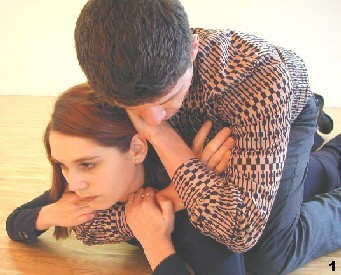 |
 |
|
Fig. 1: The opponent applies a stranglehold on Melanie's neck. Melanie grabs the strangle arm with both hands to relieve the pressure on her neck.
|
Fig. 2: Now she puts her chin underneath the attacker's arm to stabilize her neck.
|
 |
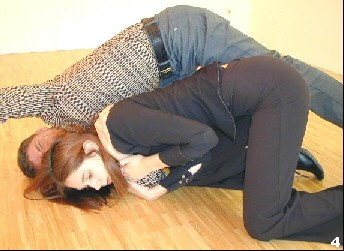 |
|
Fig. 3: Melanie bends both knees at the same time.
|
Fig. 4: She begins to roll over her right shoulder. The opponent is thrown.
|
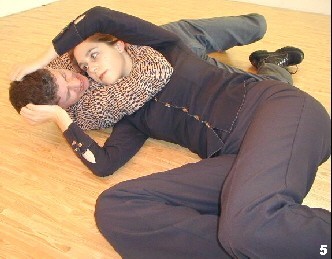 |
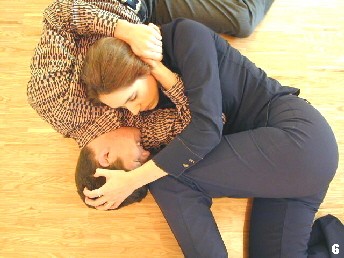 |
|
Fig. 5: After the opponent has been thrown he still continues locking her head. Melanie reaches over to grab his hear.
|
Fig. 6: She attacks him by striking with her knee.
|
| By applying a forward roll we can increase our chances of using our hands and legs due to change of position. In order not to hurt your neck, you should not roll over your head, but diagonally over your shoulders. If you succeed in pulling down the strangle arm with both arms, you may also apply a bite to free from the lock. |
Exercise 109: Defense Against Rear Naked Choke in a Sitting Position → Counterstrike with Claw Hand to the Opponent's Eyes
CLASSICAL WING TSUN EXTENDED
Wing Tsun Lesson 20: Opponent Applies a Rear Naked Choke
Exercise 109: Defense Against Rear Naked Choke in a Sitting Position → Counterstrike with Claw Hand to the Opponent's Eyes
Initial Position
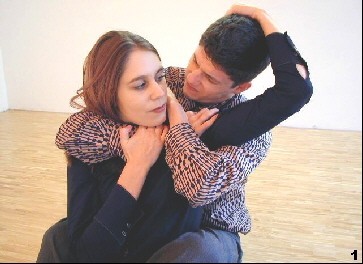 |
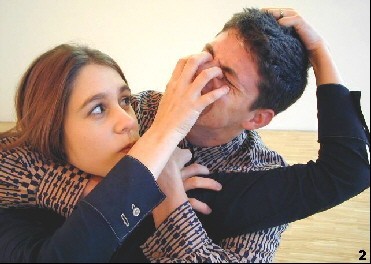 |
| Fig. 1+2: The attacker strangles Melanie in a sitting position from behind. In order to reduce the effect of the stranglehold, Melanie pulls down the wrist of the opponent's arm. With her second hand, she pulls her opponent's hair and carries out a clawing attack to his eyes. |
The loosening of the grip could also be accomplished by performing several downward elbow strikes to the unprotected rips of the opponent. Instead of the claw hand, you can also perform a hook or uppercut. It is important to execute all this quickly and resolutely because you might run out of time by losing consciousness (interruption of the blood flow of the throat arteries!).
|
Exercise 110: Defense Against Grip to Arms in Lying Position (Wide Arm Position) → Downward Knee Strike And Kick
CLASSICAL WING TSUN EXTENDED
Wing Tsun Lesson 21: Opponent is Next To Us In a Lying Position At the Ground
Exercise 110: Defense Against Grip to Arms in Lying Position (Wide Arm Position) → Downward Knee Strike and Kick
Initial Position

Exercise 111: Defense Against Grip to Arms in Lying Position (Narrow Arm Position) → "Cutting Knee Strike", Fixation of Arms and Elbow Strikes
CLASSICAL WING TSUN EXTENDED
Wing Tsun Lesson 21: Opponent is Next To Us in a Lying Position at the Ground
Exercise 111: Defense Against Grip To Arms In Lying Position (Narrow Arm Position)→ "Cutting Knee Strike", Fixation of Arms and Elbow Strikes
Initial Position
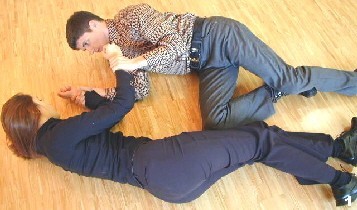 |
 |
|
Fig. 1: In the course of the fight, defender and attacker fall into a side ground position. Malanie is held by her arms.
|
Fig. 2: Since the grip of the opponent does not allow a knee strike from inside, Melanie instead lifts up her knee over the opponent's arm..
|
 |
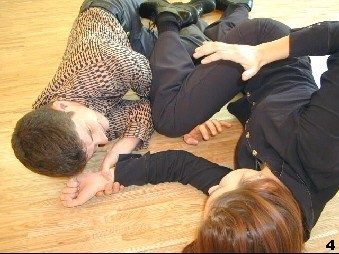 |
|
Fig. 3+4: .. with a strong downward movement, she "cuts" the opposing arm of the opponent - the grip is released. At the same time, the opposing arm is controlled by her knee.
|
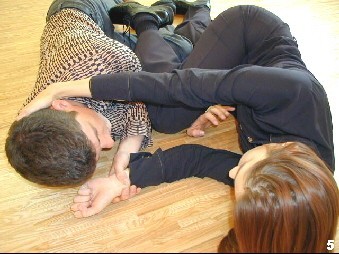 |
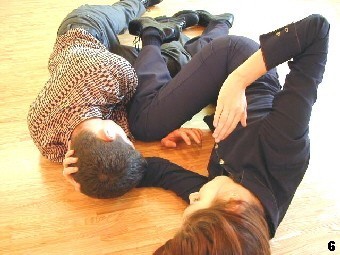 |
|
Fig. 5: Melanie now reaches for the head of the attacker with her free hand and pulls herself to the opponent.
|
Fig. 6+7: Now she grabs the opponent's neck with her left hand and carries out an elbow technique with her freed right arm.
|
 |
| The double gripping of the handle to the neck (Fig. 5-7) appears cumbersome, but it is necessary, especially since the attacking weapons of the defender could not be used on the side which is facing to the ground. |
|
Exercise 112: Opponent Holds the Defender's Arms while She Is In a Sitting Position Above → Using a Downward Knee Strike to Free From the Grip
CLASSICAL WING TSUN EXTENDED
Wing Tsun Lesson 22: Defender on Top of the Opponent In Sitting Position
Exercise 112: Opponent Holds the Defender's Arms while She is In a Sitting Position Above → Using a Downward Knee Strike to Free From the Grip
Initial Position
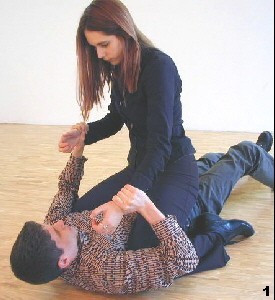 |
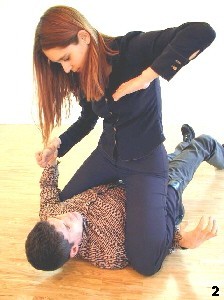 |
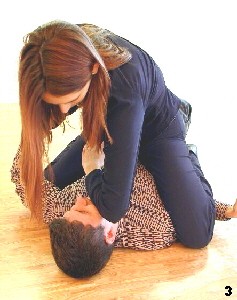 |
Fig. 1-3: In the course of the fight, Melanie manages to sit on top of the attacker but is still beeing held on both arms by the opponent. Melanie raises one leg and applies a downward knee to the attacker's upper arm. With her freed arm, she strikes down with her elbow to the opponent's head.
|
| In order to give you more stability and support while beeing in a riding position, cling to the hull of the opponent by tightening the adductor muscles. |
CLASSICAL WING TSUN EXTENDED - Part 4: Defense against Cutting and Stabbing Weapons
Exercise 113: Against Forehand Attack → Turn + Lap-Sao + Thumb Attack
CLASSICAL WING TSUN EXTENDED
Wing Tsun Lesson 23: Defense Against a Wooden Stick
Exercise 113: Against Forehand Attack → Turn with Lap-Sao and Thumb Attack
Initial Position
 |
 |
| |
|
Execute the thumb attack on the opponent's face shortly before executing the control of his attacking arm (using Lap-Sao). The technique will have been executed correctly if the thumb attack is effective even without the use of the Lap-Sao. In this execution, the opponent's head is thrown back by the impact, and he is not able to finish his attack.
|
|
Exercise 114: Against Backhand Attack → Turning Step with Lap-Sao and High Gan-Sao
CLASSICAL WING TSUN EXTENDED
Wing Tsun Lesson 23: Defense Against a Wooden Stick
Exercise 114: Against Backhand Attack → Turning Step with Lap-Sao and High Gan-Sao
Initial Position
Due to the enormous range advantage of the opponent armed with a stick, you should keep your arms close to the body. Otherwise, the opponent might hit them. At the moment the opponent moves towards you for the attack, you have to also move towards him like a sprinter. Since the thumb attack shown in the previous example would not hit the target due to the opponent's high shoulder position, your hand should slide up the shoulder to grab his neck from behind. Depending on the opponent's height, however, the thumb attack is also a possibility here.
|
Exercise 115: Against a Thrust → Pak-Sao to the Side and Noj-Bong
CLASSICAL WING TSUN EXTENDED
Wing Tsun Lesson 23: Defense Against a Wooden Stick
Exercise 115: Against a Thrust → Pak-Sao to the Side and Noj-Bong
Initial Position
Exercise 116: Against a Vertical Attack → Man-Sao and Uppercut
CLASSICAL WING TSUN EXTENDED
Wing Tsun Lesson 23: Defense Against a Wooden Stick/Bat
Exercise 116: Against a Vertical Attack → Man-Sao and Uppercut
Initial Position
 |
 |
| |
Fig.1+2: Sifu is in a neutral posture. The attacker tries to hit Sifu's head with a bat from top to bottom. Sifu first raises his arm in Man-Sao and takes a turning step, going to the opponent's side.
|
 |
 |
| |
|
In the above example, two successive body turns are executed quickly. One escaping the attack by going to the opponent's side and the other in the preparation for the elbow attack. Perform both turns at a fast pace - something similar to a clock pendulum. This will give more strength and dynamism to the counter-attack movement.
Note: These images were made in 1999, therefore, the Man-Sao pictured here represents the knowledge available at the time. We now recommend that you keep the back of your fist turned to the outside while raising your arm to deflect the bat attack. The delicate surface of the ulna is, thus, protected and the deflection of vertical attacks can occur without injury to the forearm.
|
|
Exercise 117: Against a Knife Thrust to the Abdomen (In Place) → Disarming with Kick (with Shoes)
CLASSICAL WING TSUN EXTENDED
Wing Tsun Lesson 24: Defense Against Knives
Exercise 117: Against Knife Thrust to the Abdomen (in place) → Disarming with Kick (with Shoes)
Initial Position
 |
 |
| |
Fig. 1+2: The opponent threatens Sifu Dragos with a knife, holding it up at the height of his stomach. Sifu takes a step back, out of range of a possible thrust. By transferring his weight to the back leg, a kick with the front leg is now possible. Sifu executes a quick kick with the tip of his foot to the opponent's fist. The opponent loses his knife and will now be subject to unarmed combat.
|
|
|
| |
Fig. 2a: If the opponent maintains a grip with the knife facing downwards, an upward kick with the tip of the foot will not be possible. The solution in this case will be a roundhouse kick.
|
|
 |
 |
| |
|
If you are ever attacked by someone with a knife, you will notice that, in this life-threatening situation, it is almost impossible to stop a knife attack with your arms. Therefore, it is important to keep as much distance as possible to the opponent. This is achieved by retreating and using kicking techniques. Due to the relatively low position of the knife in front of the opponent's abdomen, we can reach his wrist easily.
|
|

Exercise 118: Against Cut or Thrust to the Face (In Place) → Deep Kick to the Ankle
CLASSICAL WING TSUN EXTENDED
Wing Tsun Lesson 24: Defense Against Knives
Exercise 118: Against Cut or Thrust to the Face (in place) → Deep Kick to the Ankle
Preliminary Exercise
 |
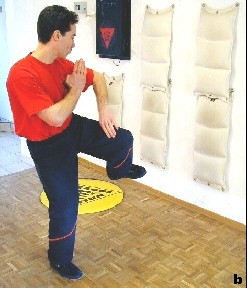 |
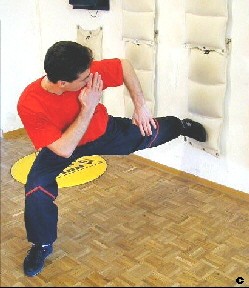 |
Fig. a-c: Sifu is standing in front of the wall bag, in a neutral position. He transfers his body weight to the rear leg, lowers the back knee and performs a sidekick close to the ground, hitting the lowest cushion of the wall bag.
|
Initial Position
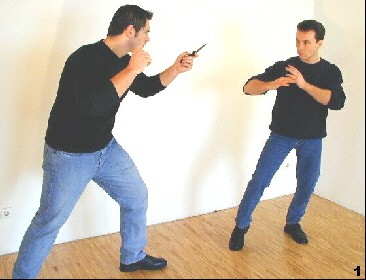 |
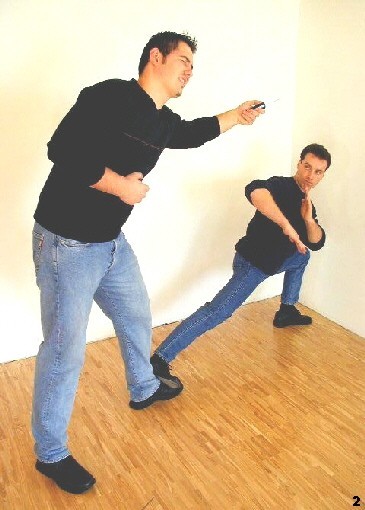 |
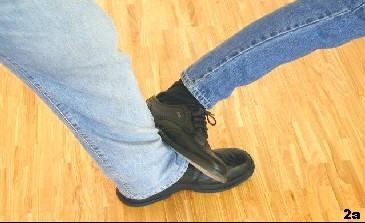 |
Fig. 1, 2, 2a: The attacker threatens Sifu with a knife and approaches. Sifu takes a step back and at the same time performs a low side kick aimed at the attacker's ankle.
|
The kick directed at the opponent's ankle makes sense when he holds the knife in such a high position that it is difficult to reach his hand with a kick. If the executed attack is successful and strong, it prevents the continuation of the opponent's attack due to injury or pain.
|
Exercise 119: Against Thrust to the Abdomen (Narrow Space) → Kwan-Shield Lap Sao / Fak-Sao
CLASSICAL WING TSUN EXTENDED
Wing Tsun Lesson 24: Defense Against Knives
Exercise 119: Against Thrust to the Abdomen (Narrow Space) → Kwan-Shield Lap-Sao/Fak-Sao
Initial Position
 |
 |
 |
| |
Fig. 3+4: Sifu instantly controls the attacker's wrist, pulling him away with a Lap-Sao. At the same time, he executes a Fak-Sao to the attacker's neck.
Fig. 4a: As an alternative to the Fak-Sao, a claw-shaped hand attack can be executed to the attacker's eyes.
|
| |
| |
Info
|
|
|
|
 |
 |
| |
|
The solutions presented here may be brutal, but one must be remember that a knife attack is a life-and-death situation that justifies such actions. Defenses using the arms are last resorts, to be used if we are cornered or have no other opportunities to gain space. When touching the opponent's arms with ours, if possible, do not expose the "inside" part of the forearm, where tendons and many blood vessels are located. This decreases the risk of more serious injuries if an accidental cut occurs.
|
|
Exercise 120: Against High Straight Thrust (Narrow Space) → BiuFak, Double Arm Pull and Knee Attack
CLASSICAL WING TSUN EXTENDED
Wing Tsun Lesson 24: Defense Against Knives
Exercise 120: Against High Straight Thrust (Narrow Space) → BiuFak, Double Arm Pull and Knee Attack
Initial Position
 |
 |
| |
Fig. 3+4: Sifu controls the opponent's wrist with a Lap-Sao. His other arm presses the opponent's arm up (Tok-Sao). Sifu steps forward with his left leg and pulls himself toward the opponent. The following knee attack is performed with the back leg and, thus, has enough force to incapacitate the opponent.
|
 |
 |
 |
 |
| |
Tip
|
|
| |
| |
|
The pull on the opponent's arm must be made in such a way that it does not allow a protective movement with his elbow. Otherwise, it may happen that our knee is injured by an eventual collision.
|
|
| |
| |
|
|
Exercise 121: Against High Diagonal Cut From Above (Narrow Space) → High Gan-Sao, Fak-Sao and Knee Attack
CLASSICAL WING TSUN EXTENDED
Wing Tsun Lesson 24: Defense Against Knives
Exercise 121: Against High Diagonal Stab From Above (Narrow Space) → High Gan-Sao, Fak-Sao and Knee Attack
Initial Position
 |
 |
| |
Fig. 1+2: Armed with a knife, the opponent approaches Sifu Dragos and performs a downward diagonal cut aimed at his neck. Sifu executes a turn with "falling-step" (Cham-Kiu Step) and executes a High Gan-Sao ("Cutting Hand") to the opponent's forearm. The opponent's arm will be restrained by the movement of Sifu's trunk (and depending on the force, it may be injured or disarmed).
|
|
|
 |
|
 |
| |
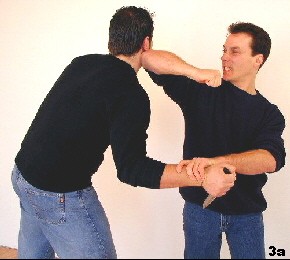 |
|
| |
| |
Fig. 3a: If the opponent narrows the distance, approaching more, after the execution of our first defense with High Gan-Sao, it is possible to apply a reverse elbow strike to his head.
|
| |
Fig. 4: Finally, Sifu grabs the opponent by the neck, pulls him down using the force of gravity and attacks the opponent's solar plexus with his knee.
|
|
 |
 |
| |
|
Do not execute the High Gan-Sao directly to the opponent's fist, aiming for his forearm instead. The reason is the potential risk of accidental cutting. With appropriate intensity, the opponent drops the weapon after the collision of the arms.
|
|
DRAGOS WING TSUN
DWT 1.0: Quick-Defence (The Complete Student Program)
DRAGOS WING TSUN - QuickDefence
153 Free exercises for Combat Systems from DWT 1.0
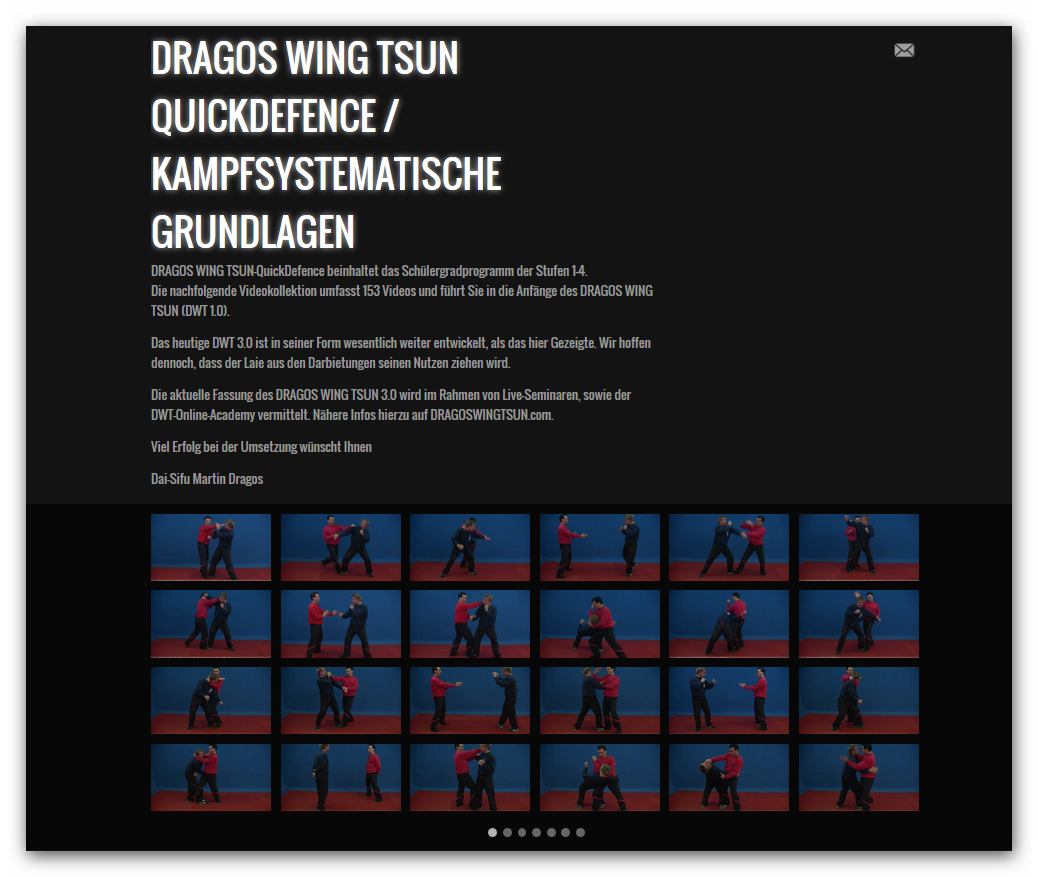
DRAGOS WING TSUN-QuickDefence includes the Student Degrees (SG) 1 through 4. The following video collection comprises 153 videos and guides the enthusiastic layman through the early days of DRAGOS WING TSUN (DWT 1.0). The current DRAGOS WING TSUN 3.0 is much more developed in its essence and form than what is demonstrated here. However, we hope that the enthusiastic layman will be able to find useful information from the performances presented here. The current version of DRAGOS WING TSUN 3.0 is taught in face-to-face seminars, as well as in the DWT-Online-Academy.
DWT 1.0: Technical Series - Slideshow (Extracts From the Early Years of the WT-Masters-Academy)
Technical Sequence - Slideshow DRAGOS WING TSUN 1.0
Image sequence from the early years of DRAGOS WING TSUN (2003 - 2006)
The following technical series were developed in the early years of the DRAGOSWINGTSUN (DWT 1.0), in which classical Wing Tsun was complemented and modified by DWT concepts. The historical weaknesses of the WT system ("Missing links") should be corrected. Numerous previously unknown concepts, e.g. "relative force", 3-levels protection, isometrics, fight systematics, pre-contact strategies, space work, use of the weapons footwork into the unarmed part of the system, adjustment for the internal and external principle and so on. Over the years an independent overall concept has emerged - the DRAGOSWINGTSUN system, which also differs greatly from traditional WT. This process of refinement and improvement continues to this day and is part of the DWT philosophy (similar to the japanese Kaizen of "Constant Improvement"). Today's DWT 3.0 is, in its essence, the most advanced version of the DWT. It is taught through seminars and the online academy.
The fragments shown here are essentially image sequences published between 2004-2010 in the journal "Kampfkunst International". More than 100 technical series were published, which helped to bring great recognition to DWT.
| Tip: Use the arrow keys on your keyboard for fast scrolling. |
 |
DWT 1.0: Special Contributions From "Kampfkunst-International"
DWT 3.0: Form Training - Siu Nim Tao, Chum Kiu, Biu Tze and Wooden Dummy Forms
DRAGOS WING TSUN FORMS
The Forms from the Unarmed Part of the System
The unarmed forms of the DWT include the Siu Nim Tao ("Simplified Form"), Chum Kiu ("Seeking Arms"), Biu Tze ("Thrusting Fingers") and Mok Yan Chong Fat ("Column-Used-as-Dummy" or simply "Wooden Dummy Form"). Form training allows the student to familiarize themselves with the most important movement patterns at an early stage. The first step is to recognize the movements by repetition until they can be carried out fluently. From a state of introspection (immersion/inner contemplation), eventually the ability to pay attention to the outside world grows. Only then, can the movement patterns of the forms be properly applied.
The Meaning of the Forms in Details:
The Siu Nim Tao Form serves to learn the muscle memory needed for power generation.
The Cham Kiu Form includes isolation patterns, projections and their defenses.
The BiuTze Form includes emergency solutions against isolations, collapse of arm positions, trapped arms, unavoidable collisions, loss of balance, solutions against multiple attackers and other scenarios.
The Wooden Dummy Form focuses on strategies of flanking and acquisition of the so-called "relative force". At the same time, dangerous techniques can be trained with full power.
The forms shown here are explained in details in the DRAGOS WING TSUN Online-Academy. We recommend that visitors to our seminars become familiar with the first 3 forms in advance.
To access the videos of the Forms, please click on this Link or the picture below!

DWT 3.0: Excerpts and Samples of DWT Online Academy
DRAGOS WING TSUN ONLINE ACADEMY
Excerpts and Samples of DWT-ONLINE-ACADEMY

|
|
|
|
|
|
|
|



